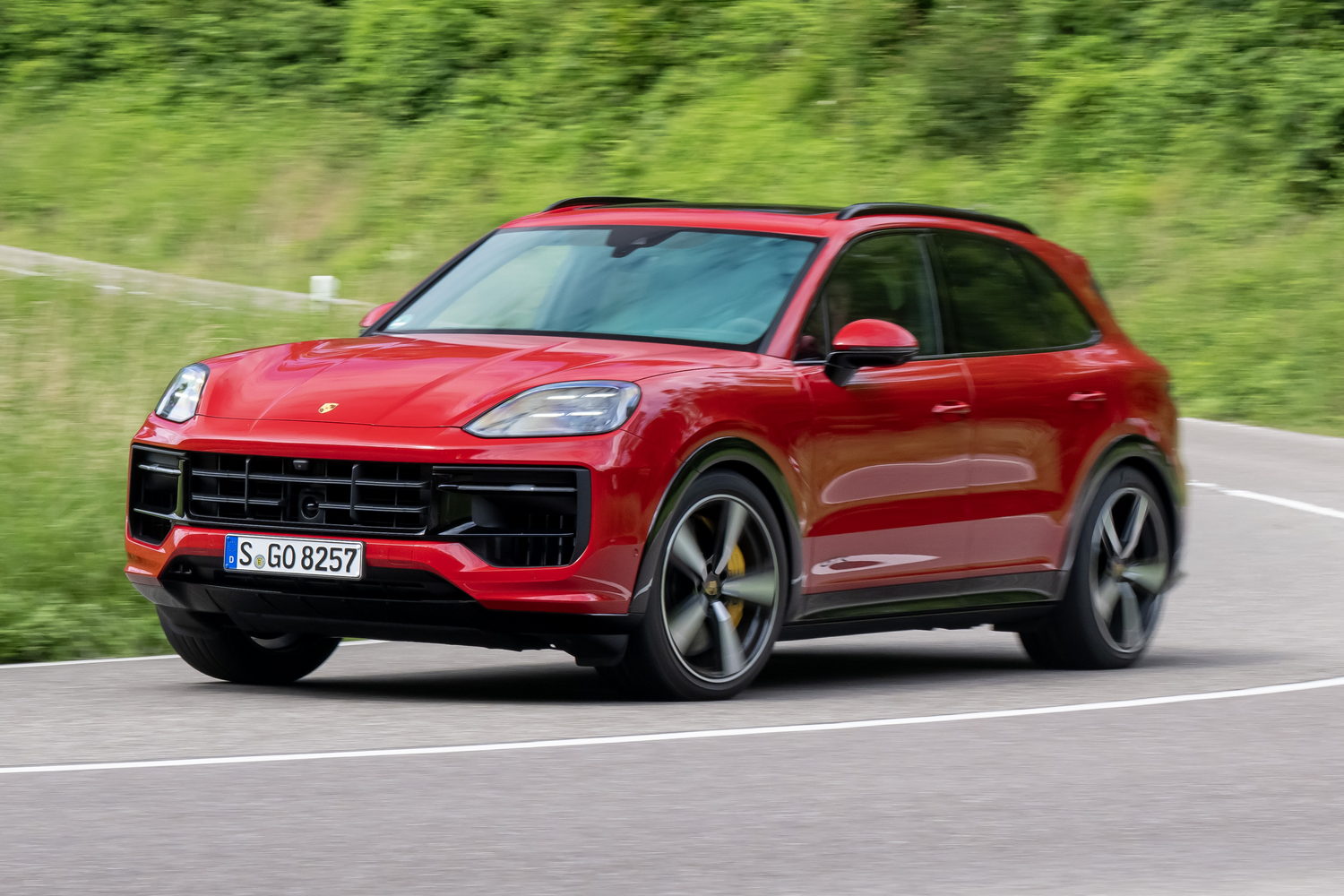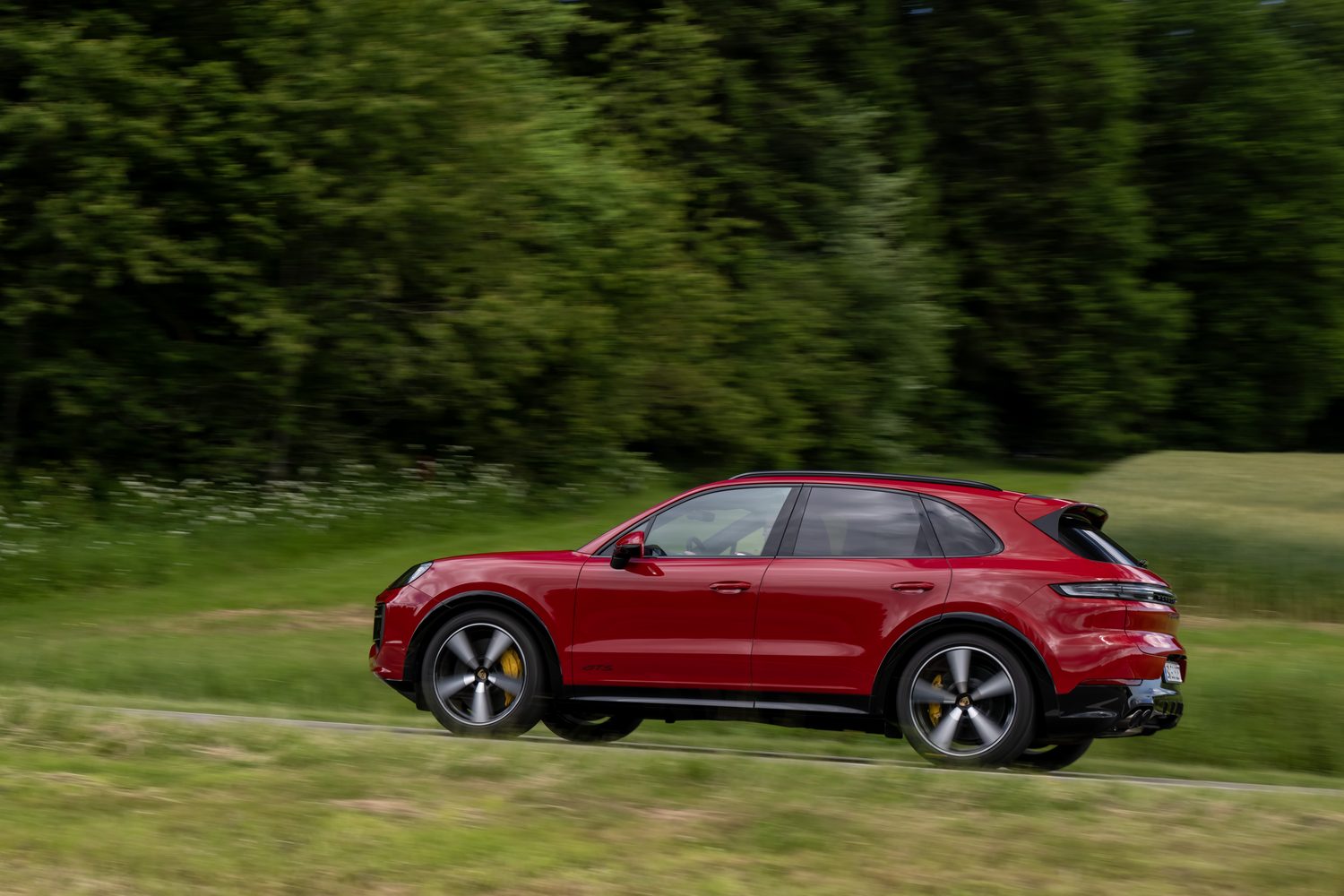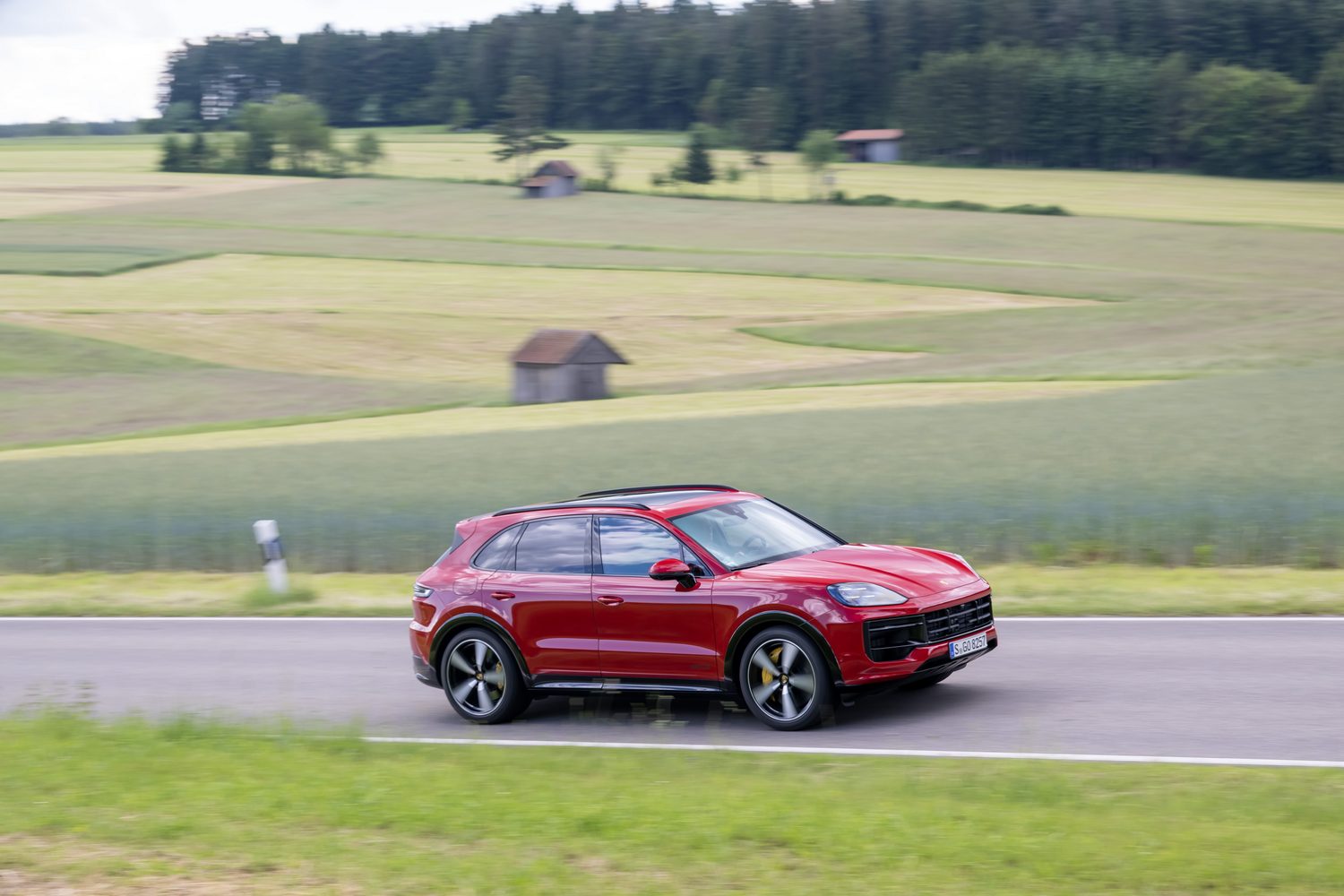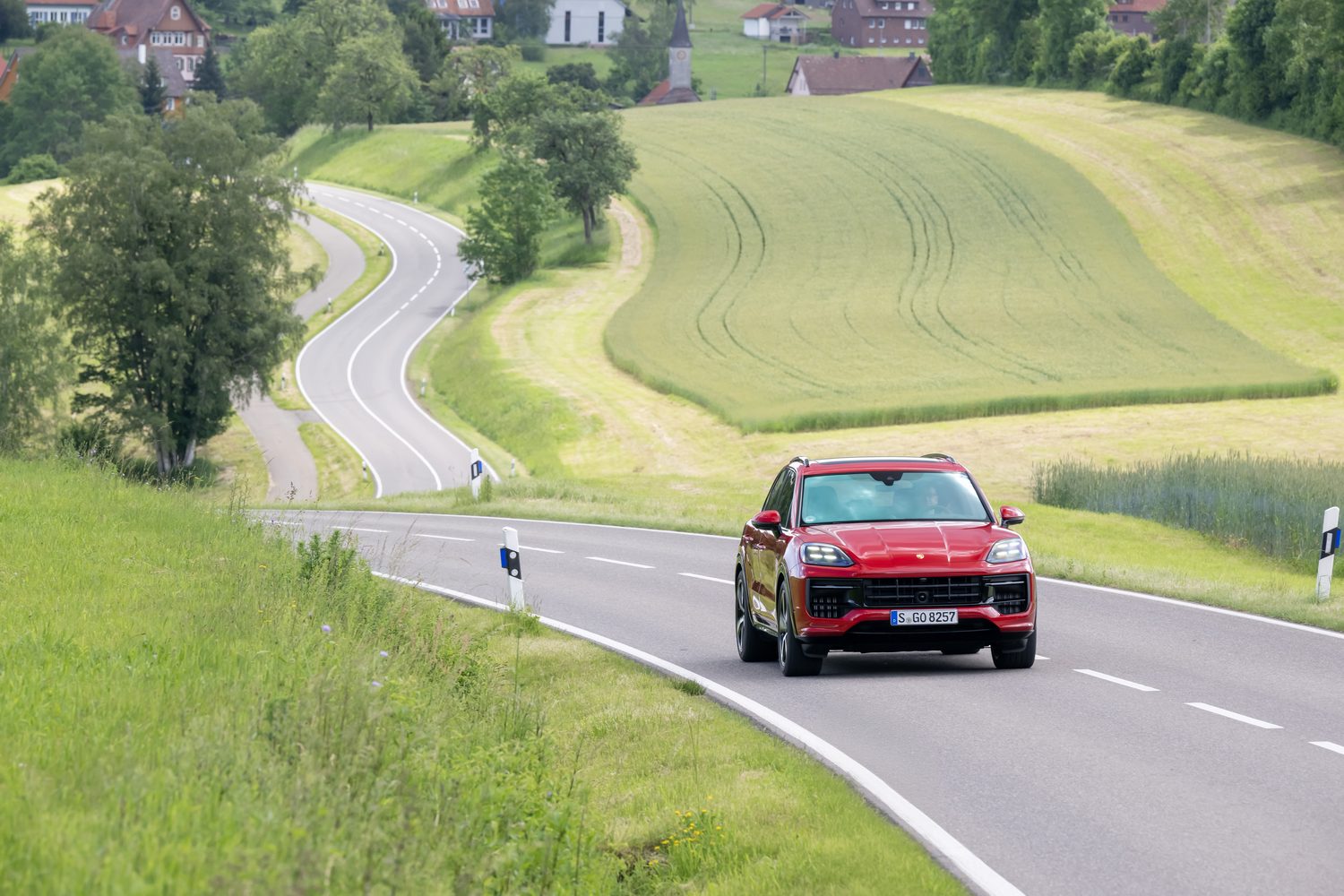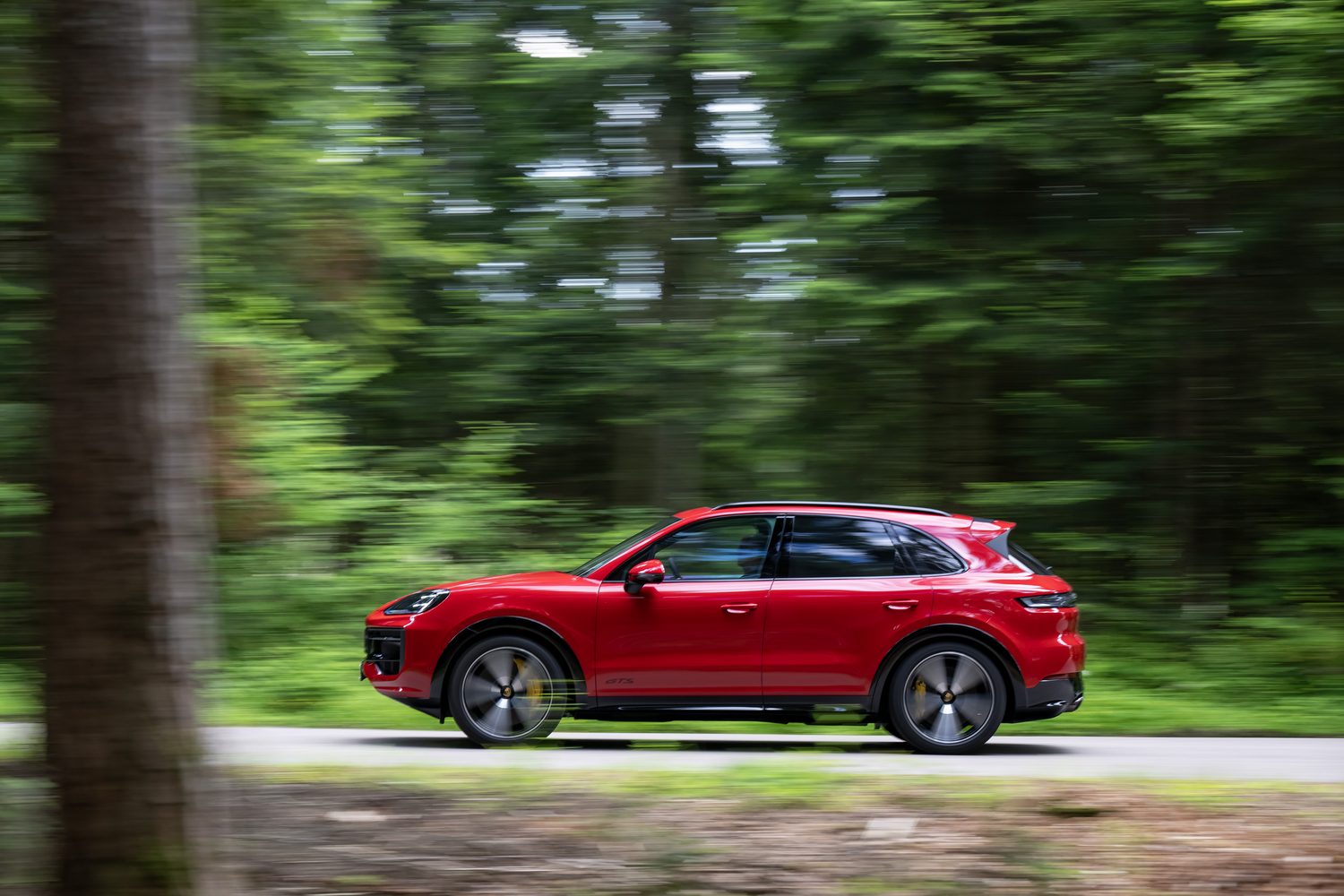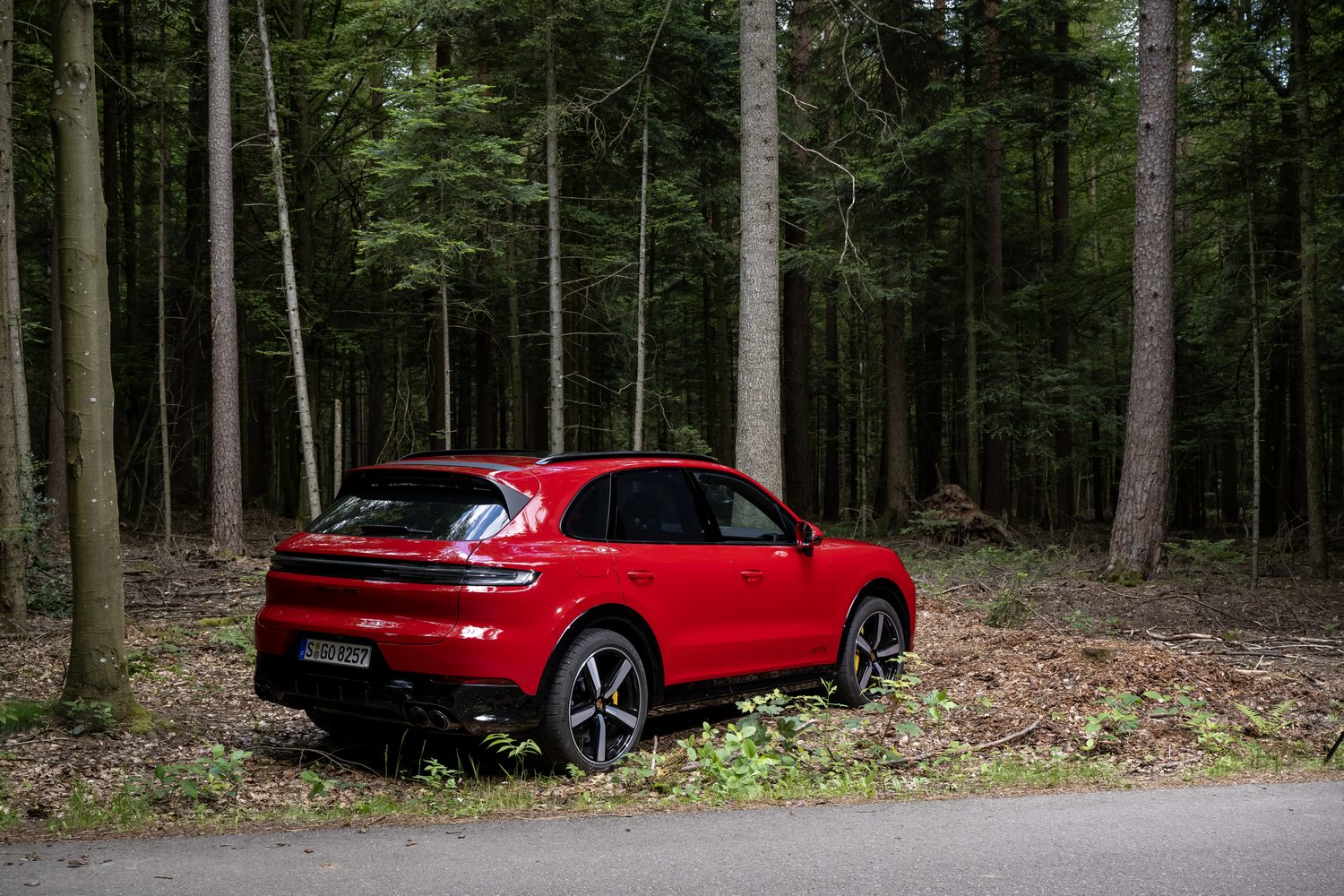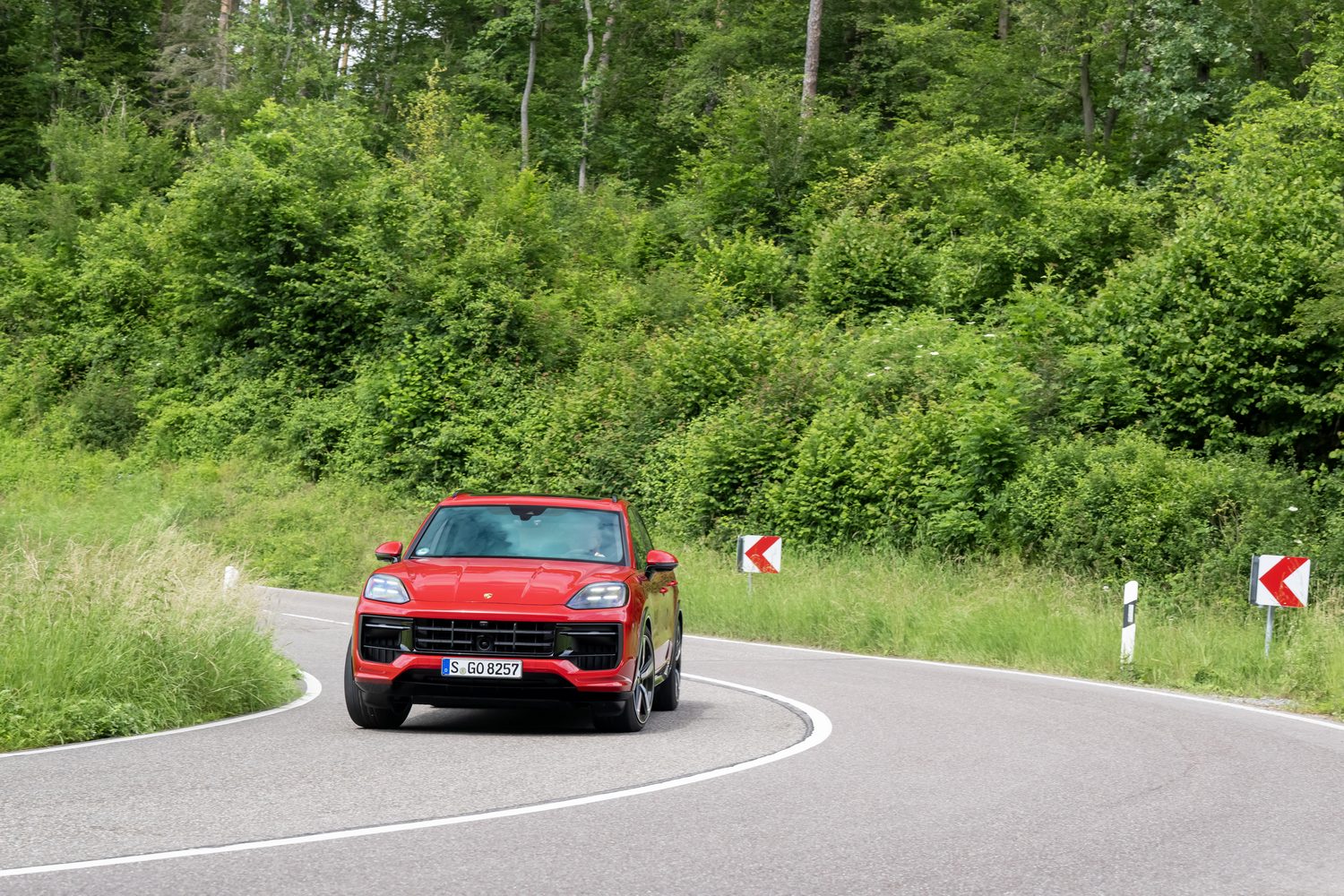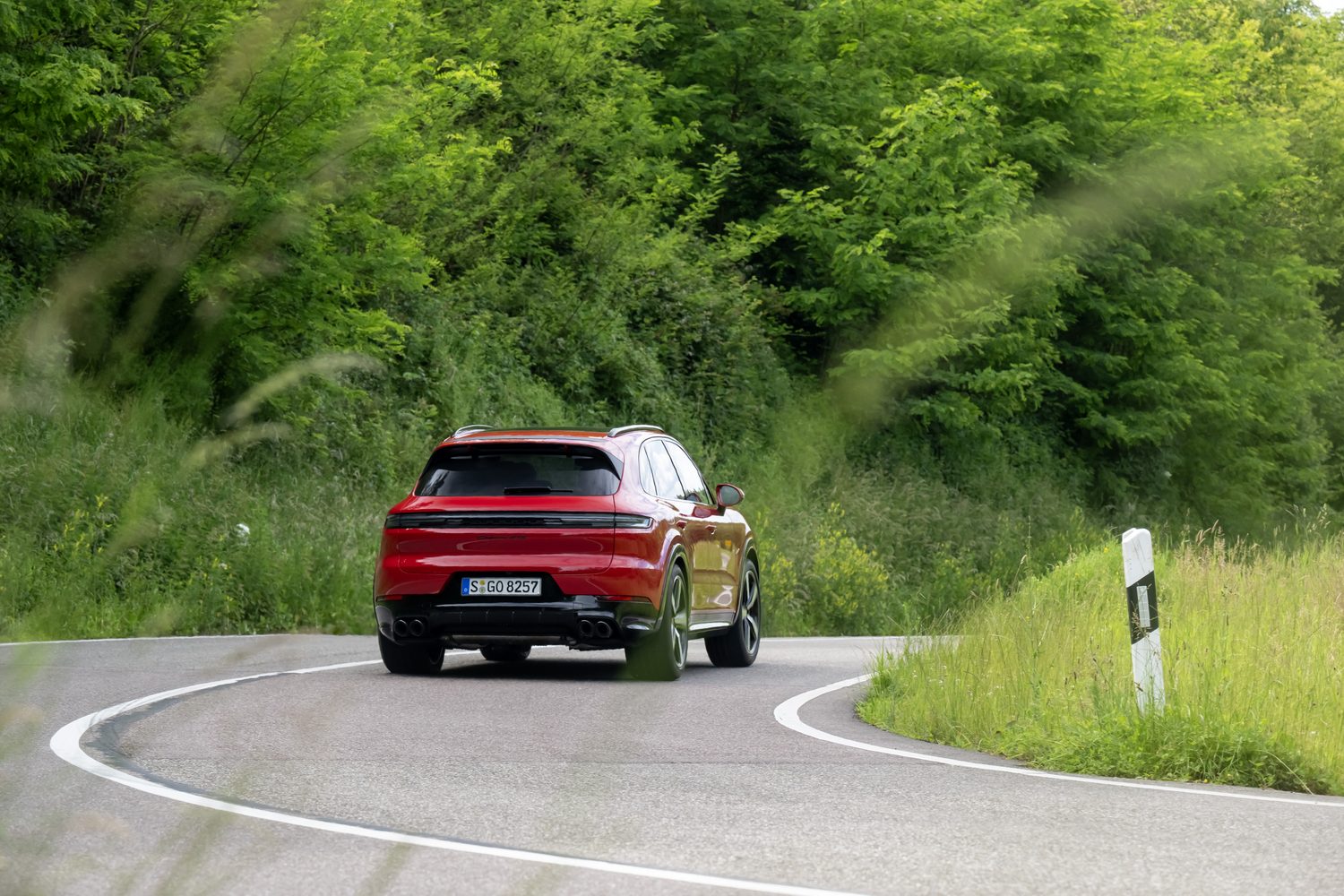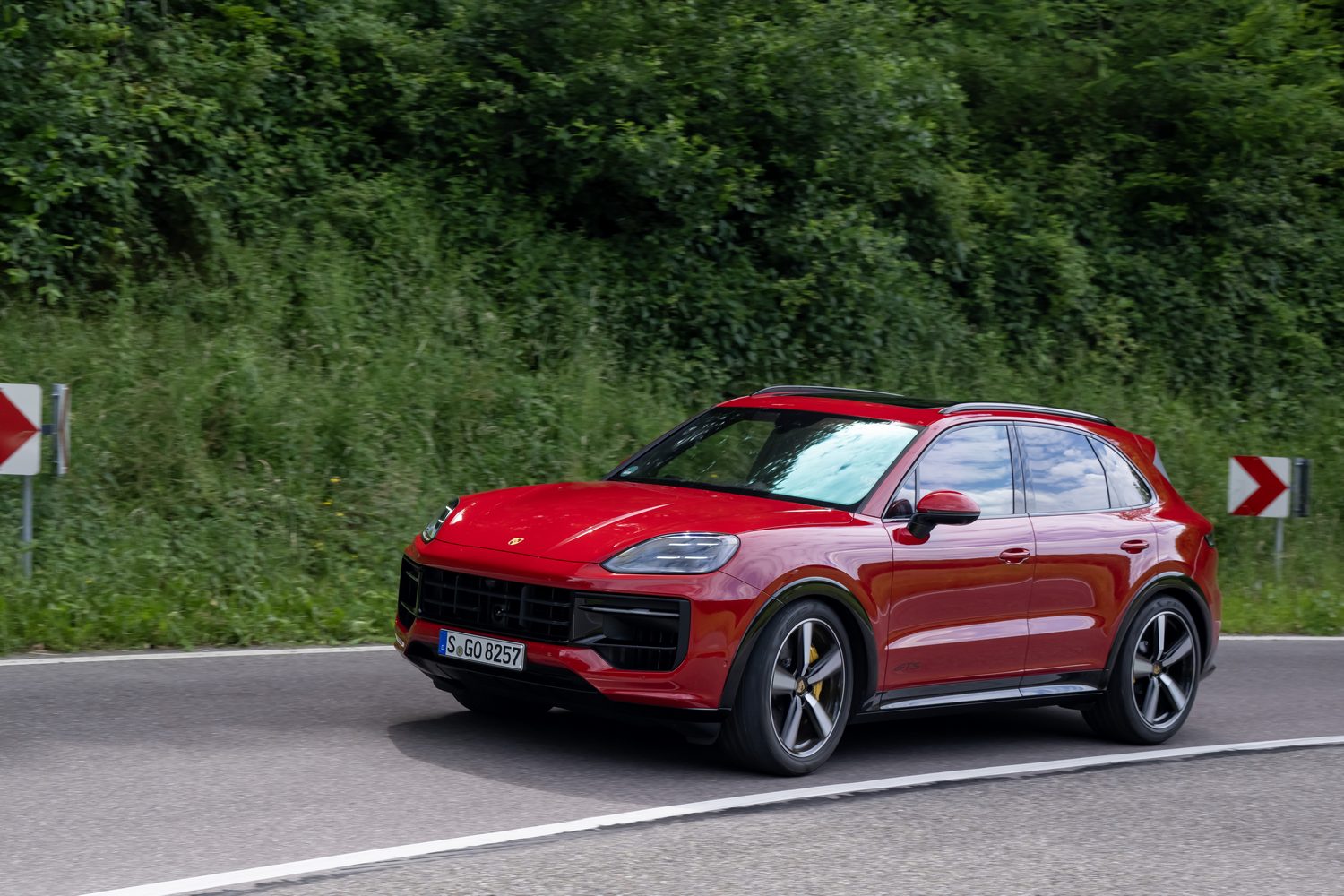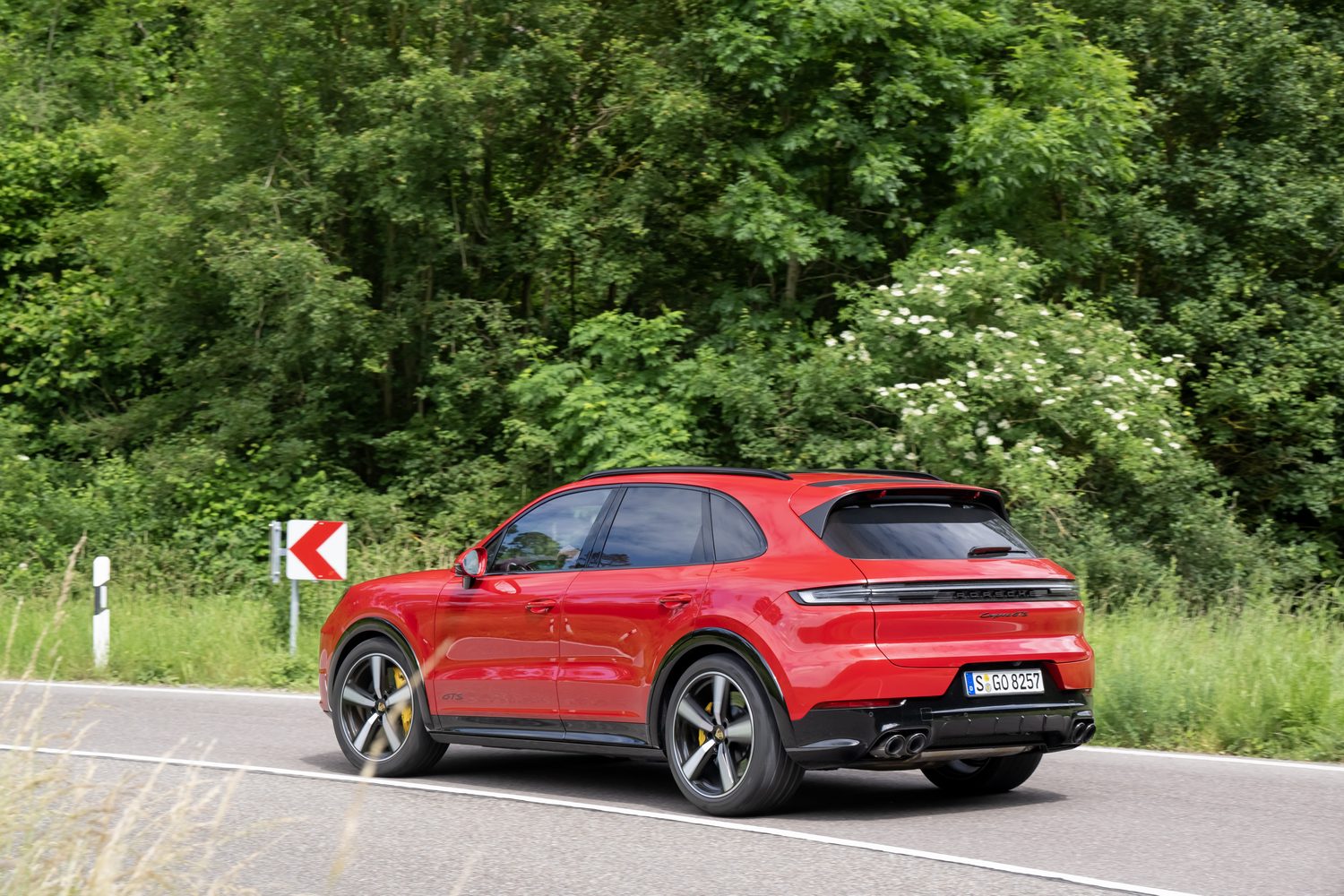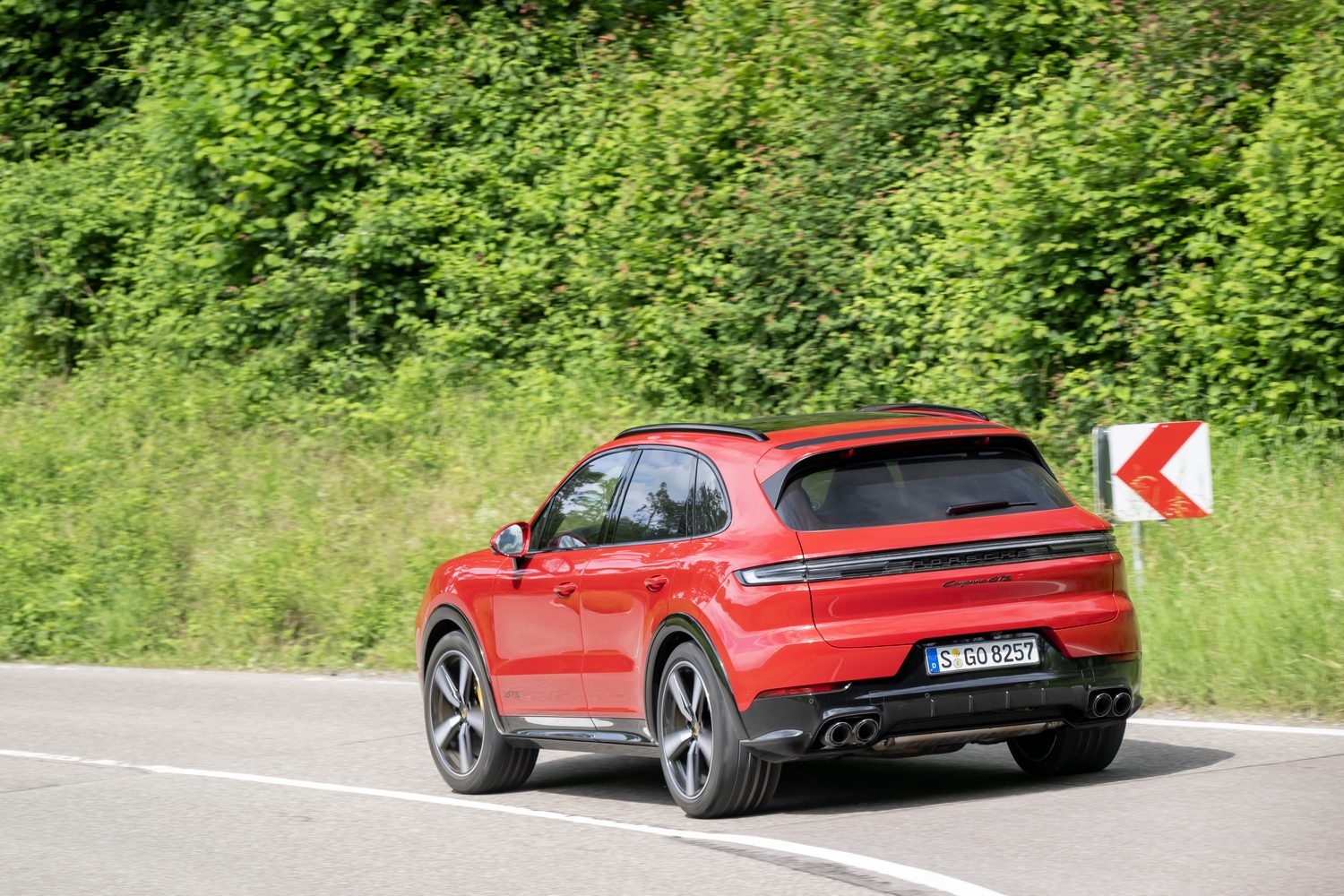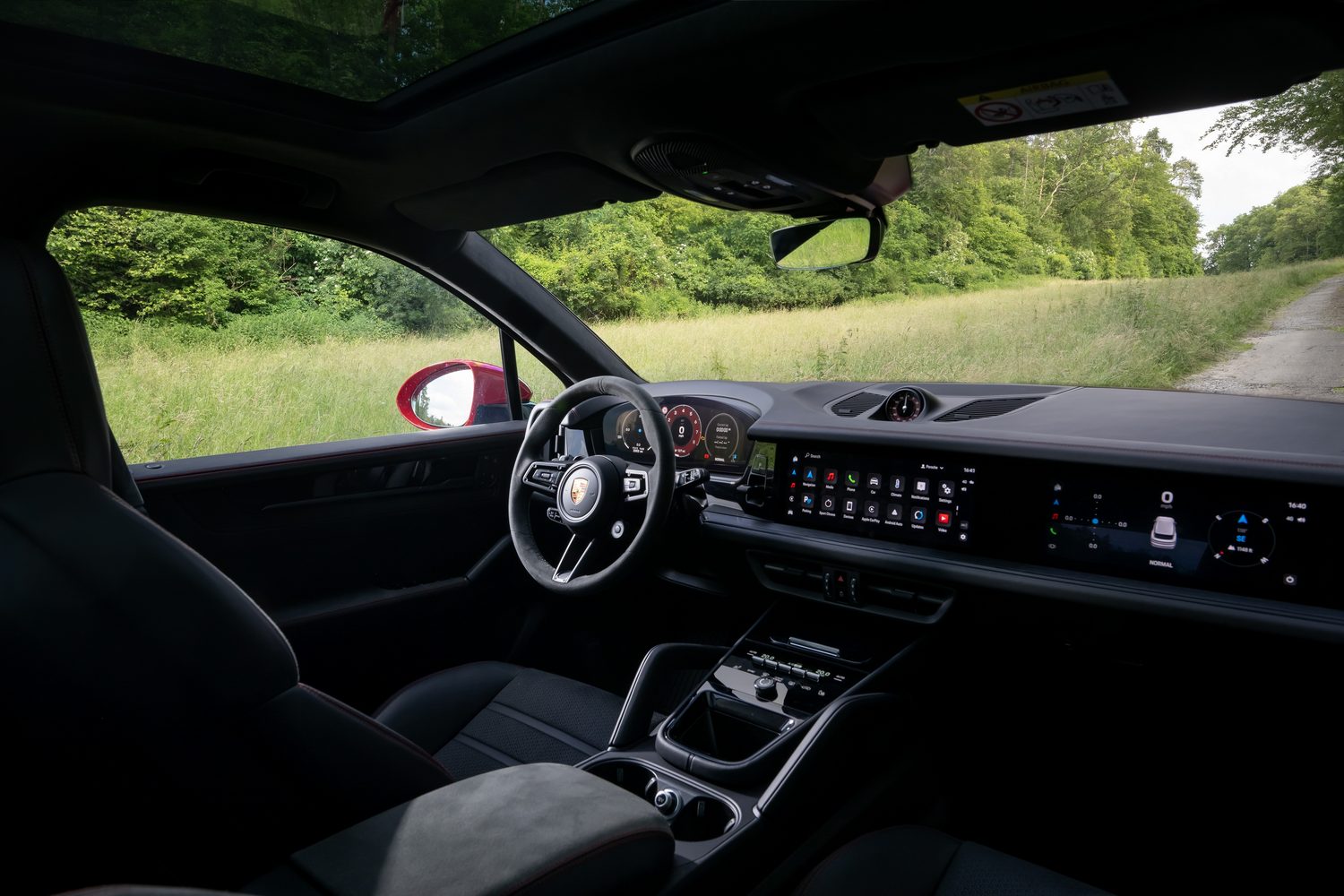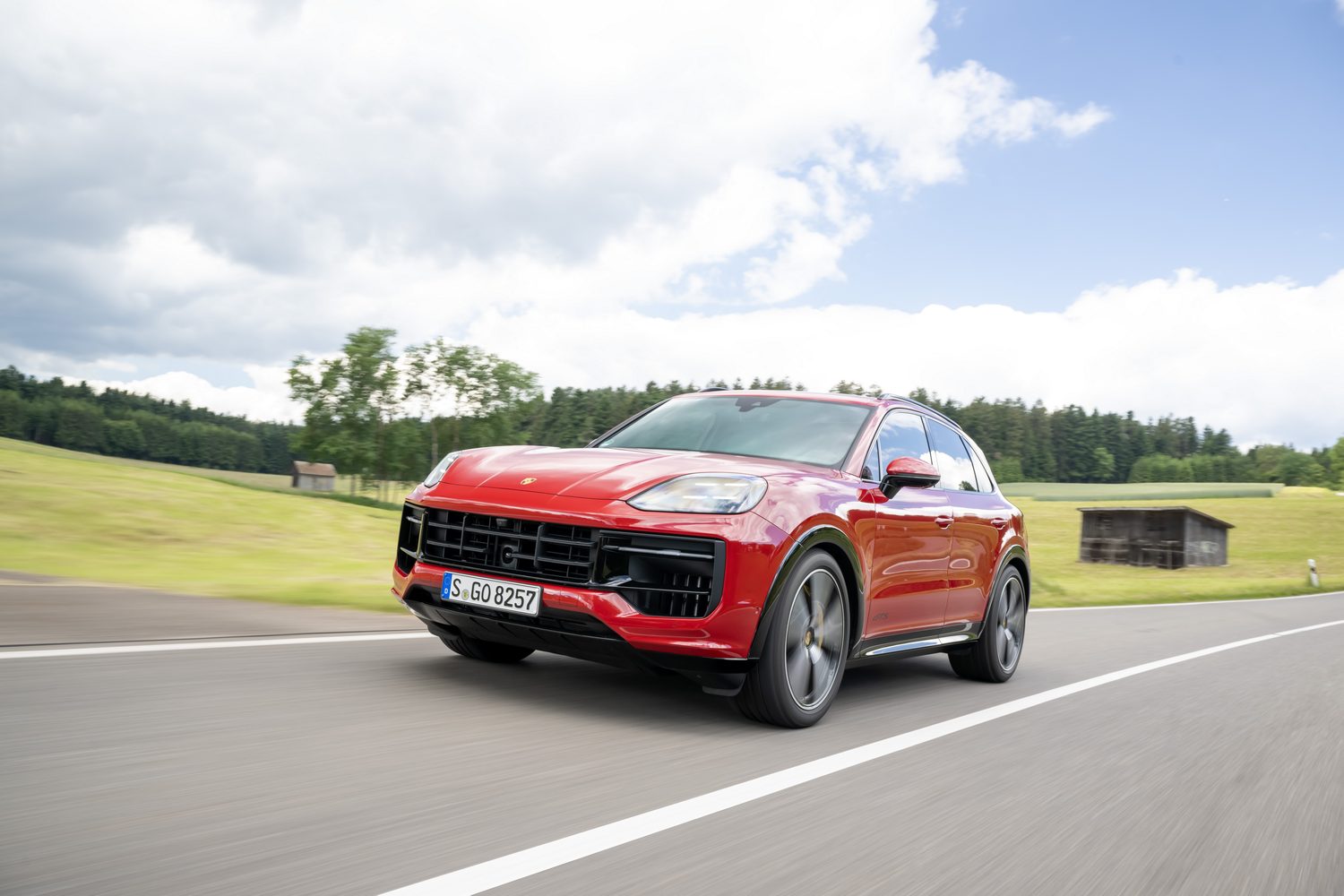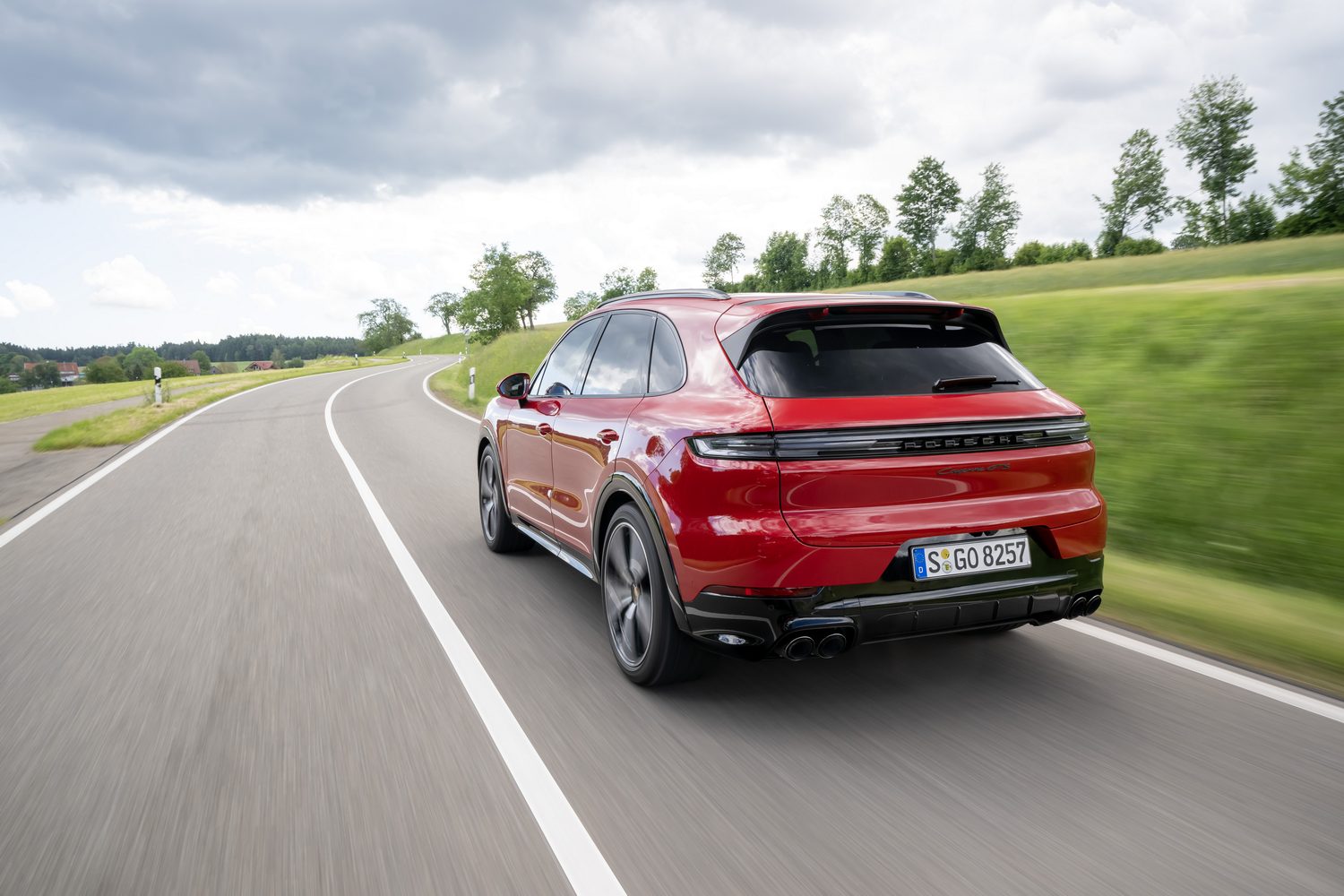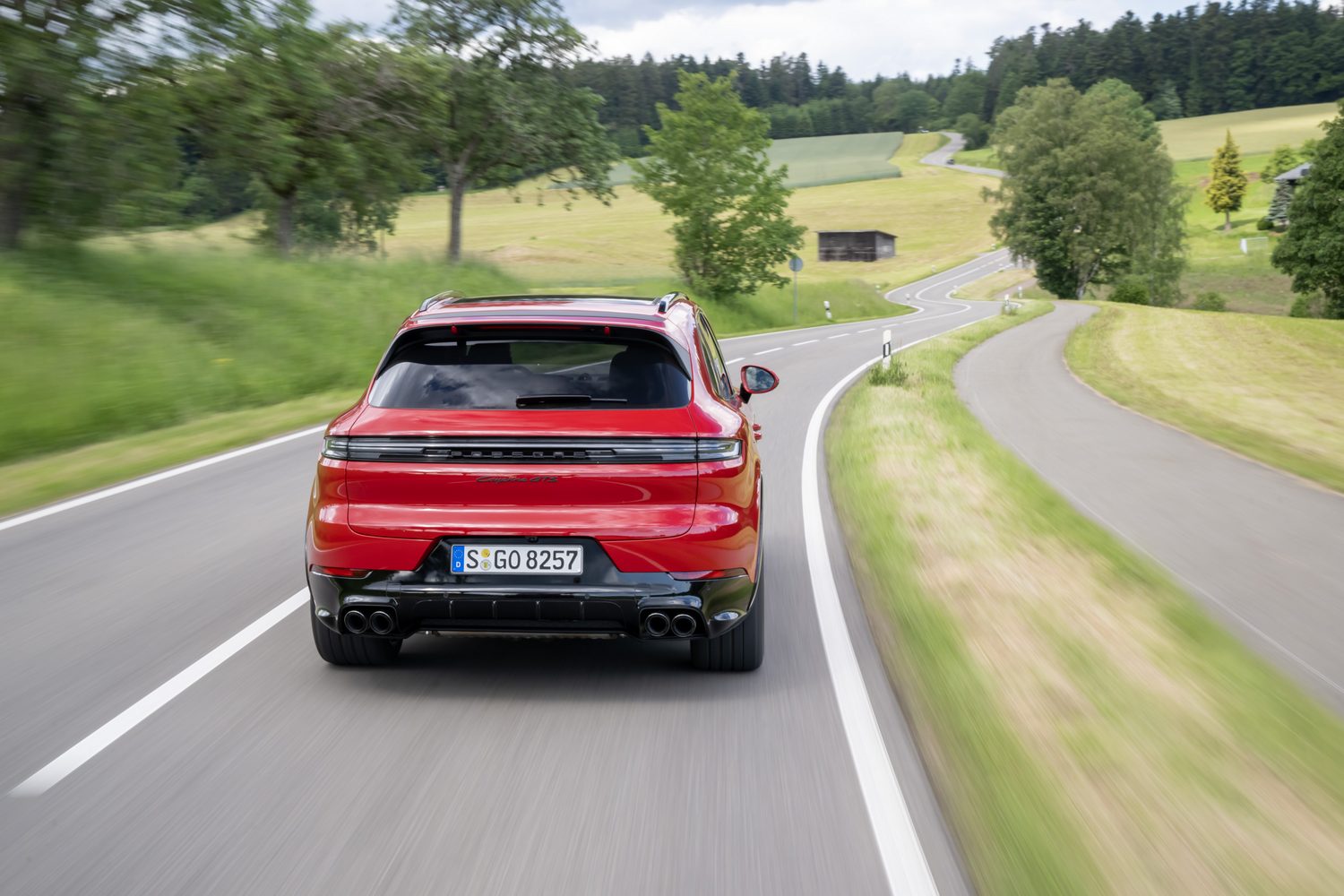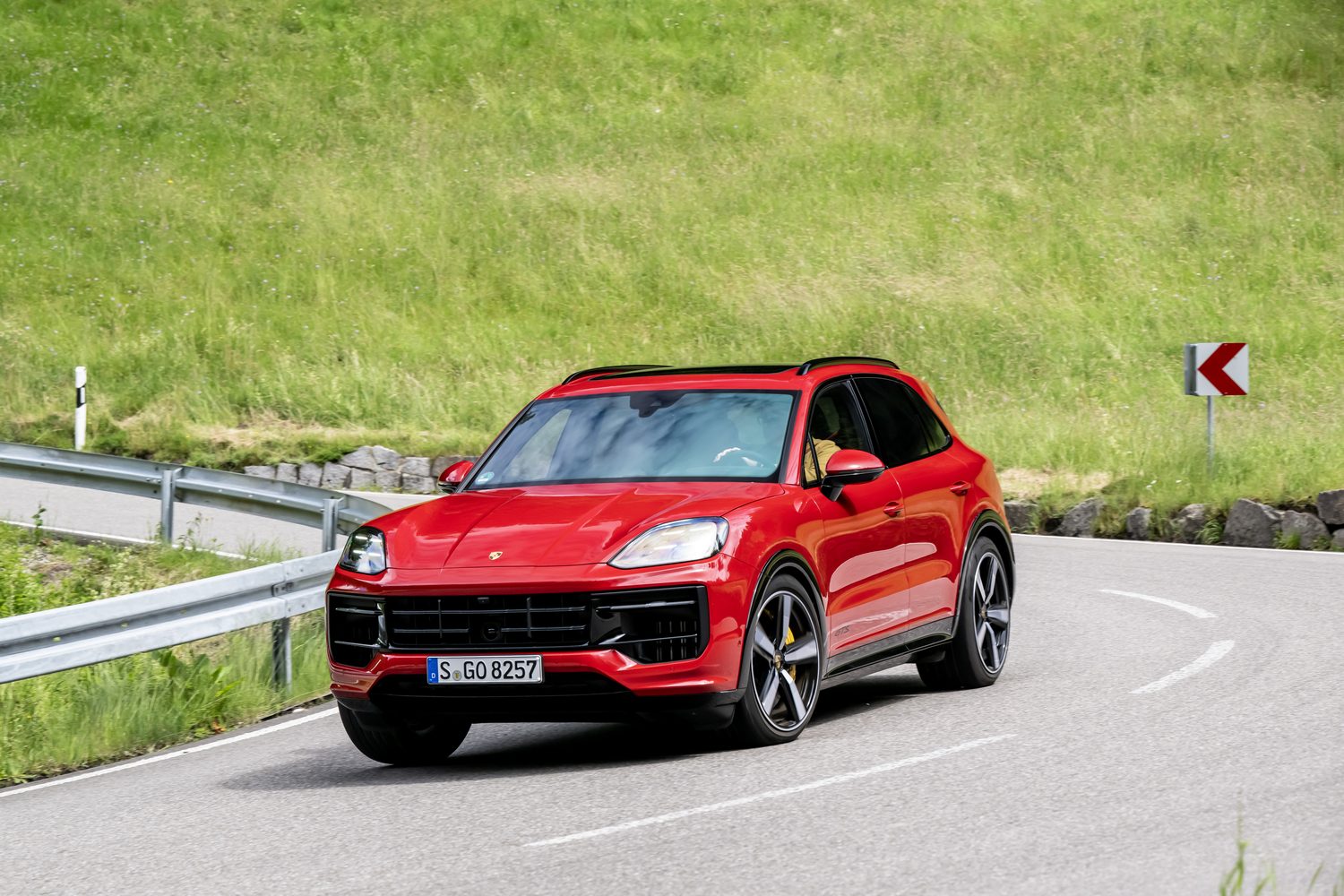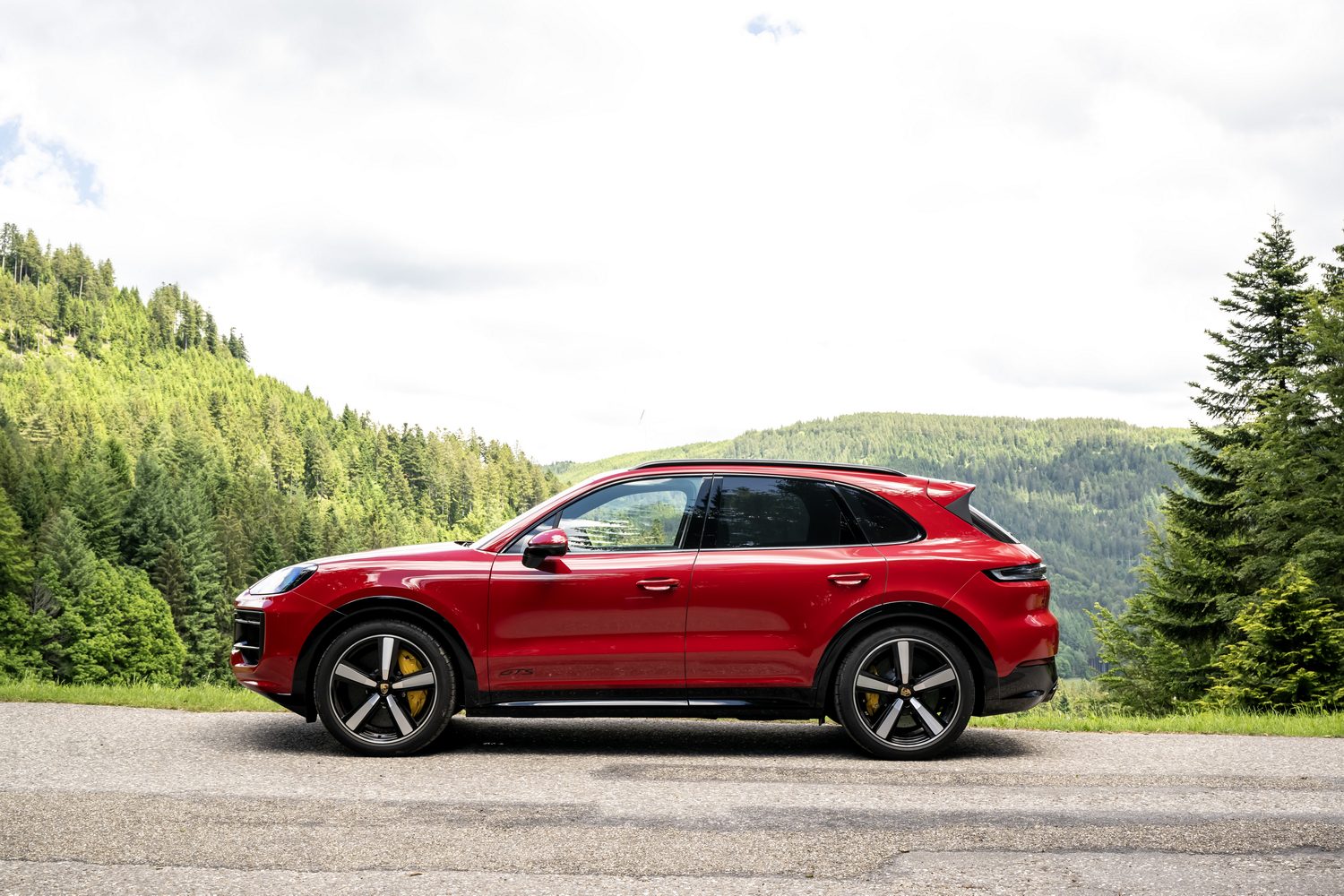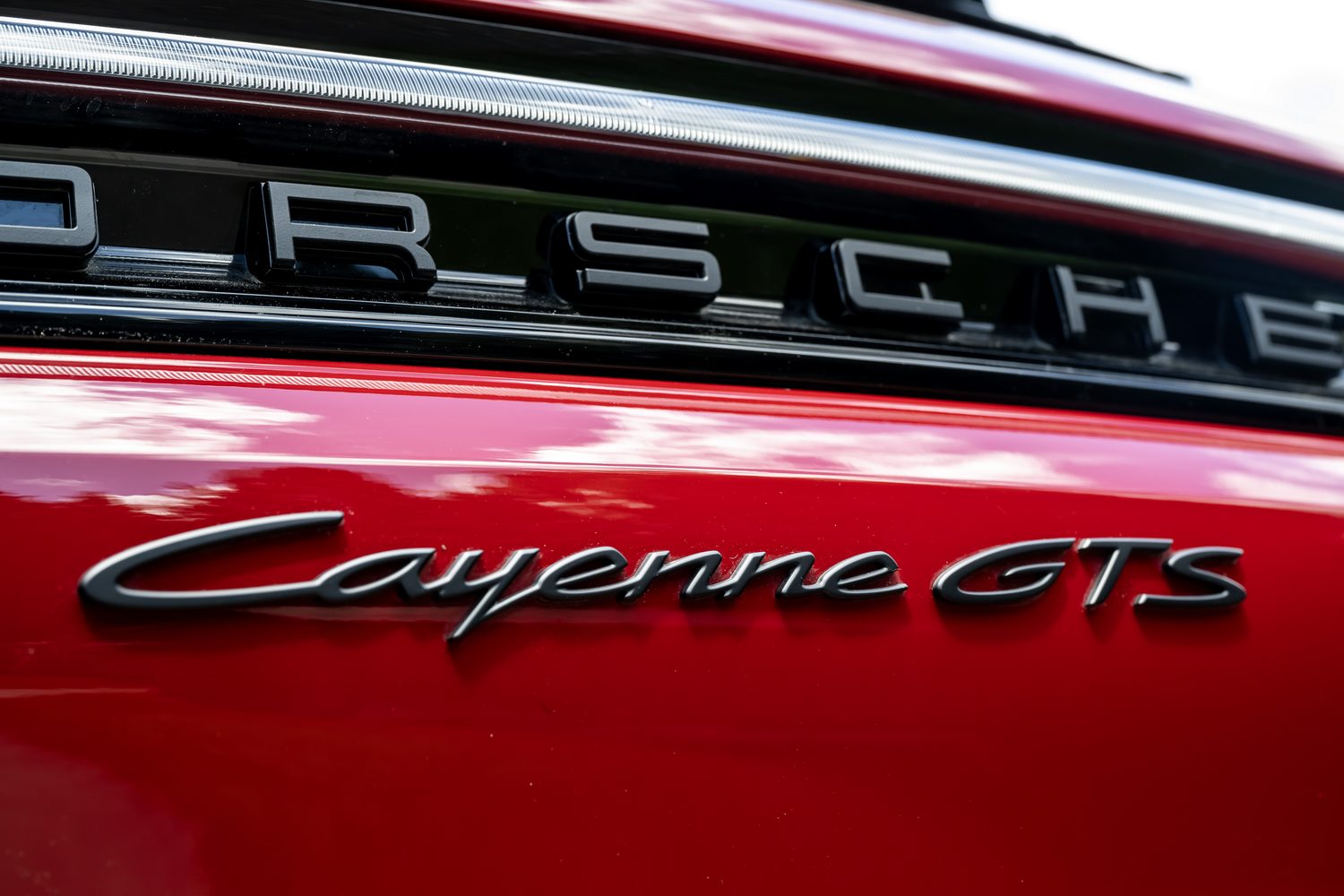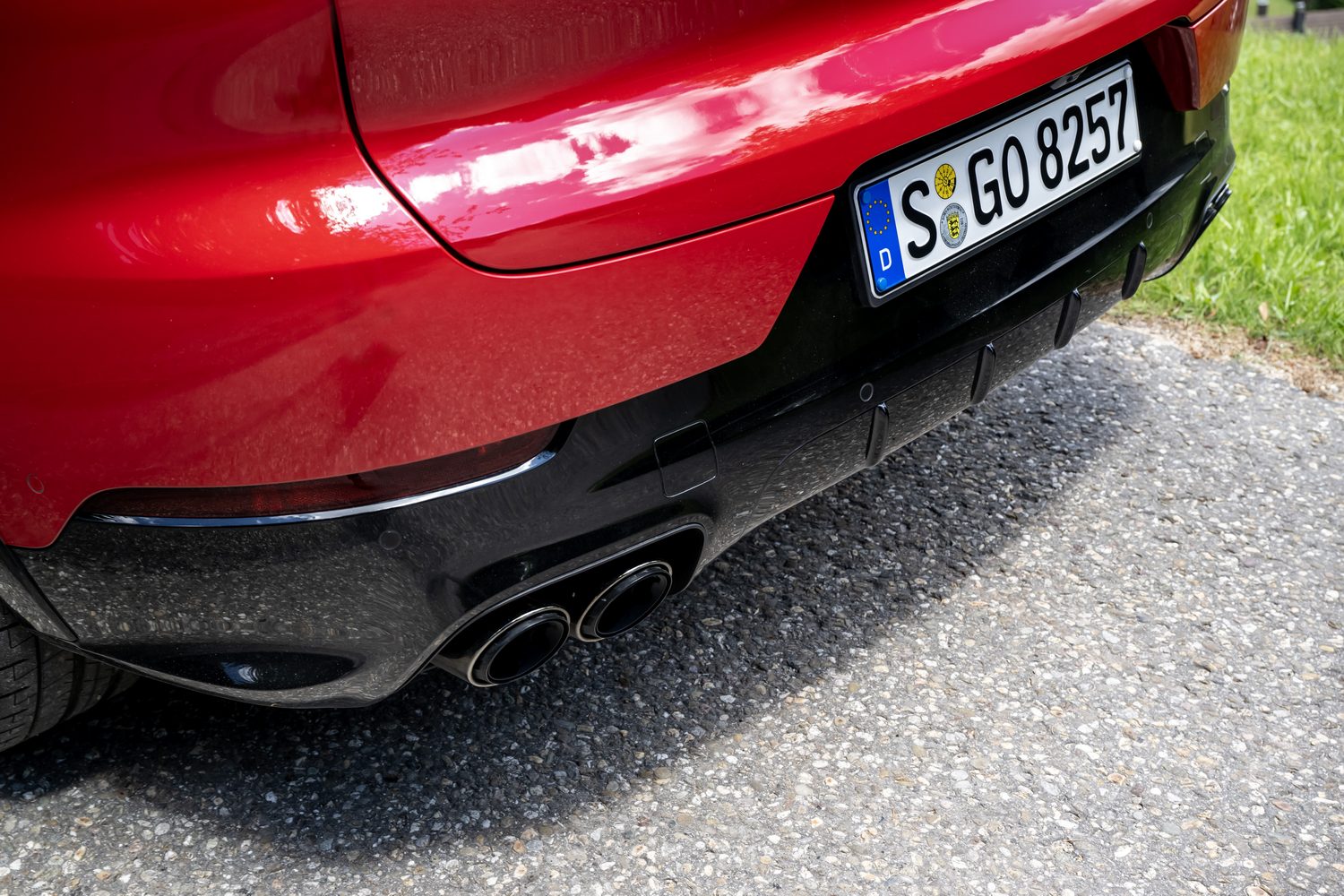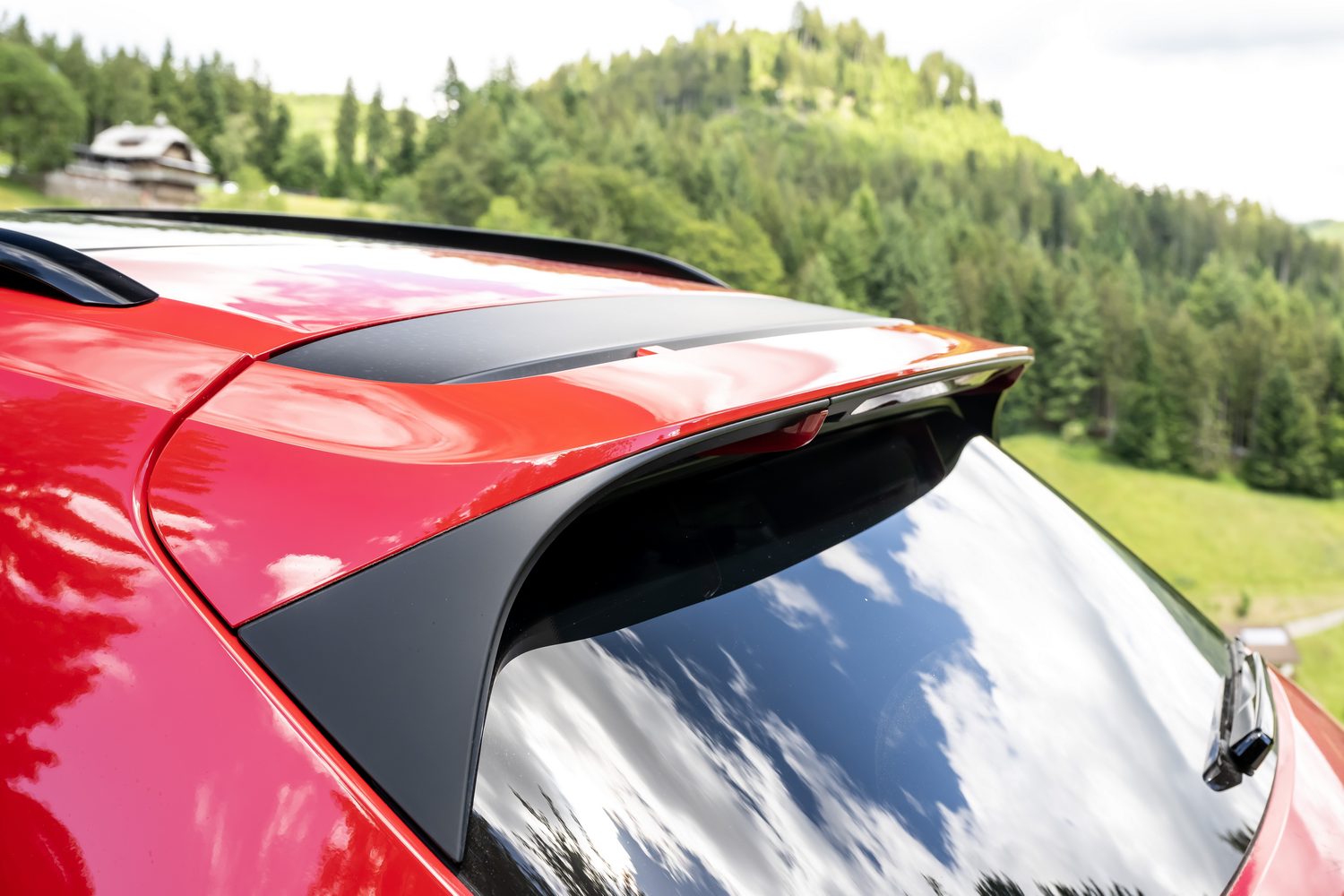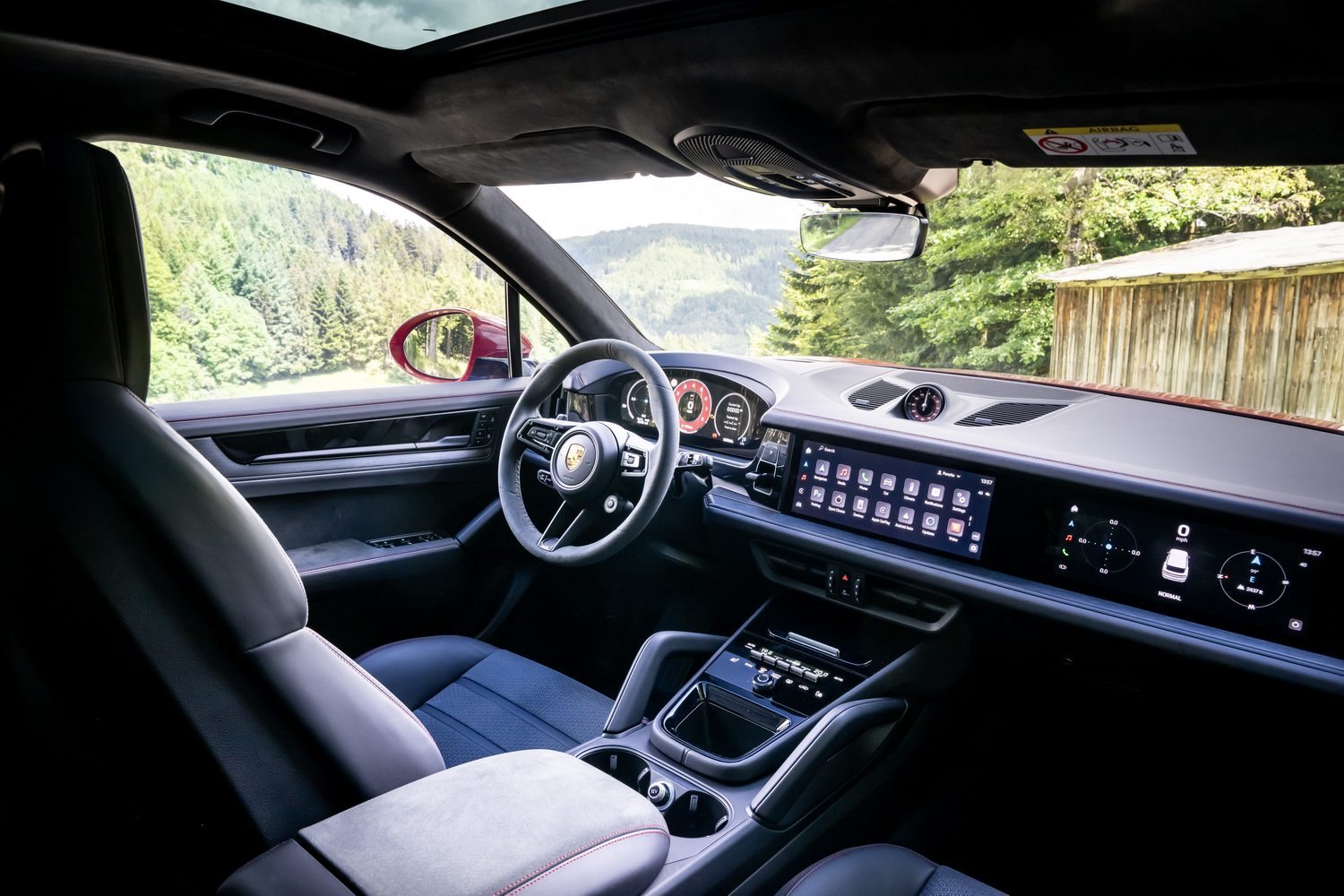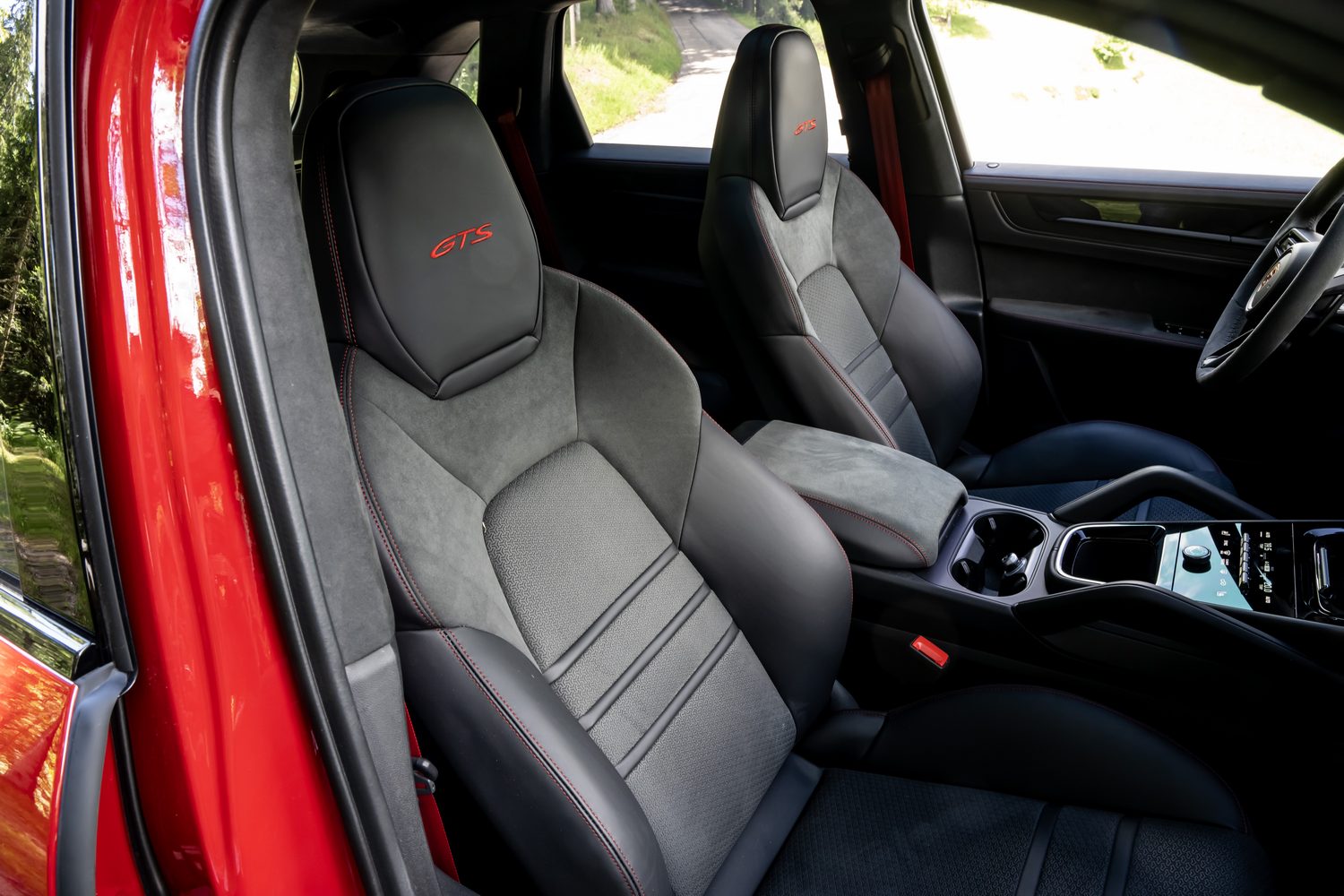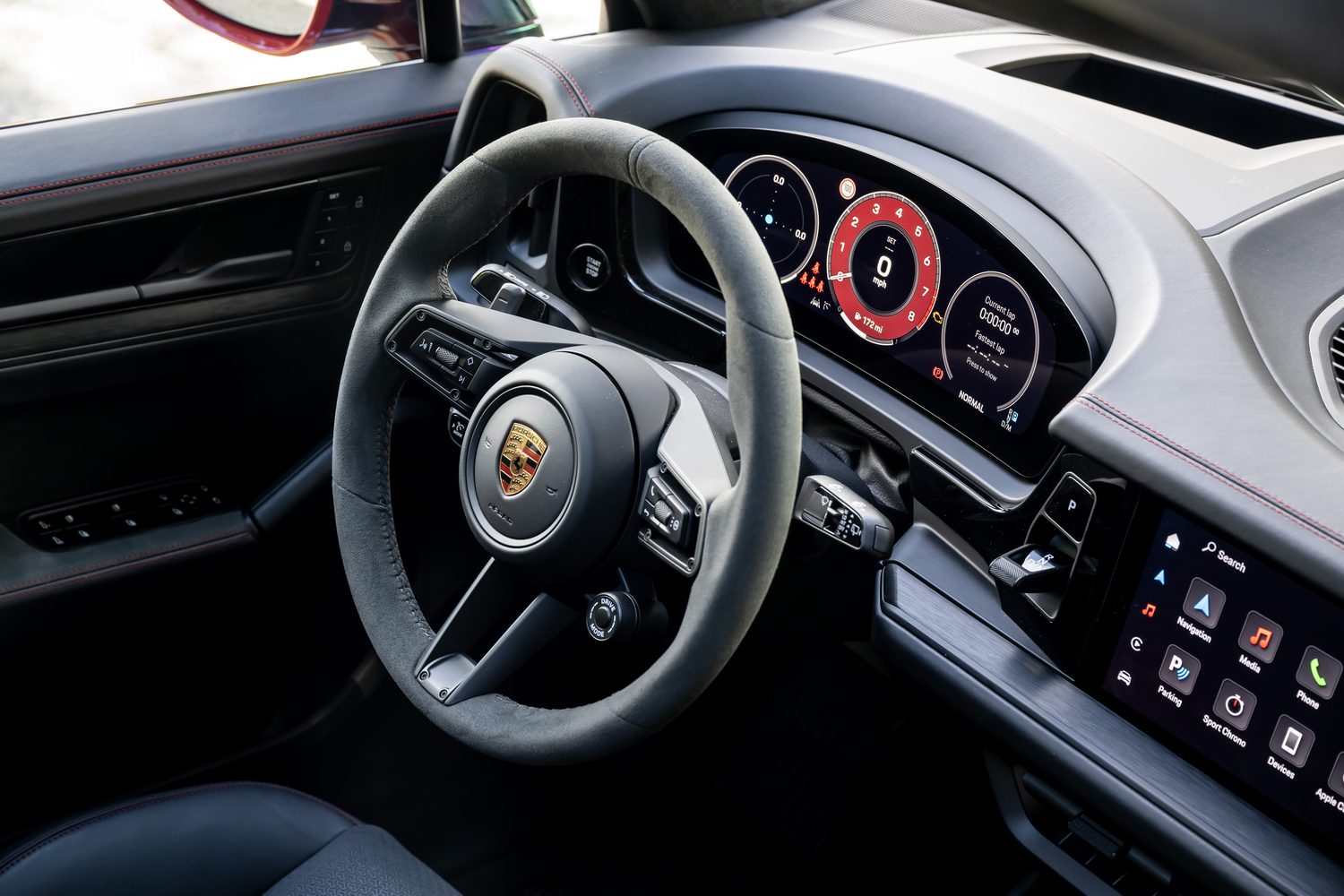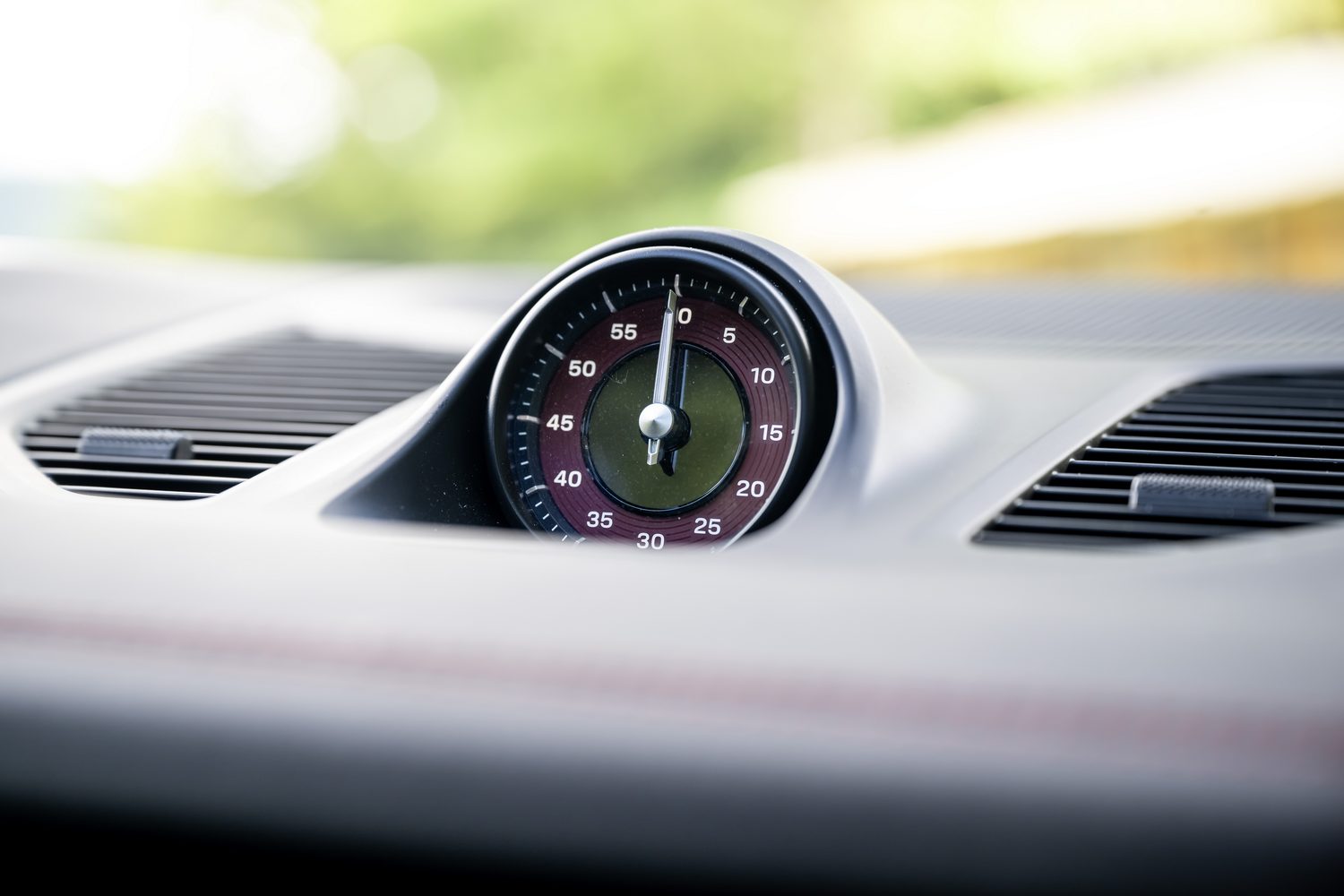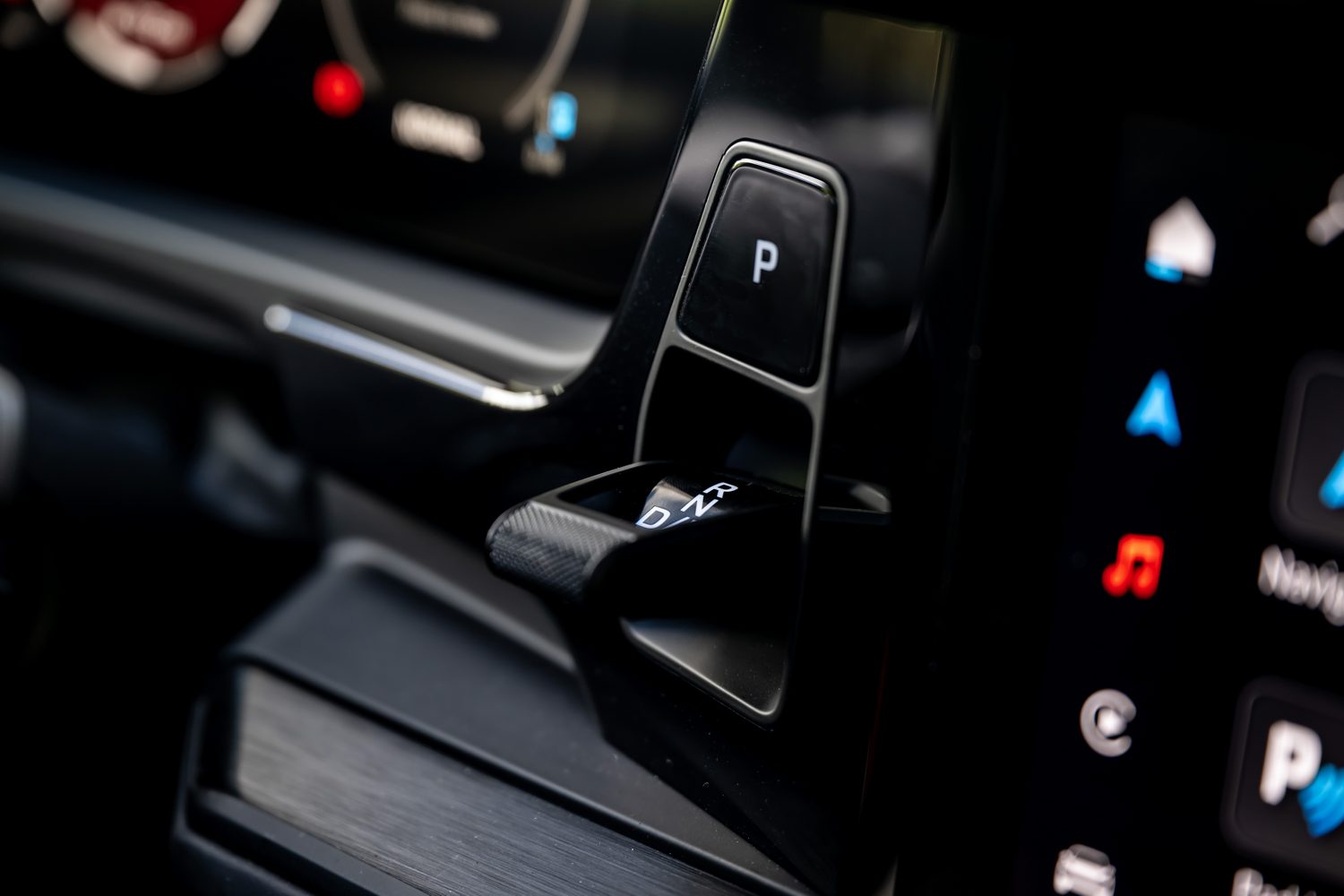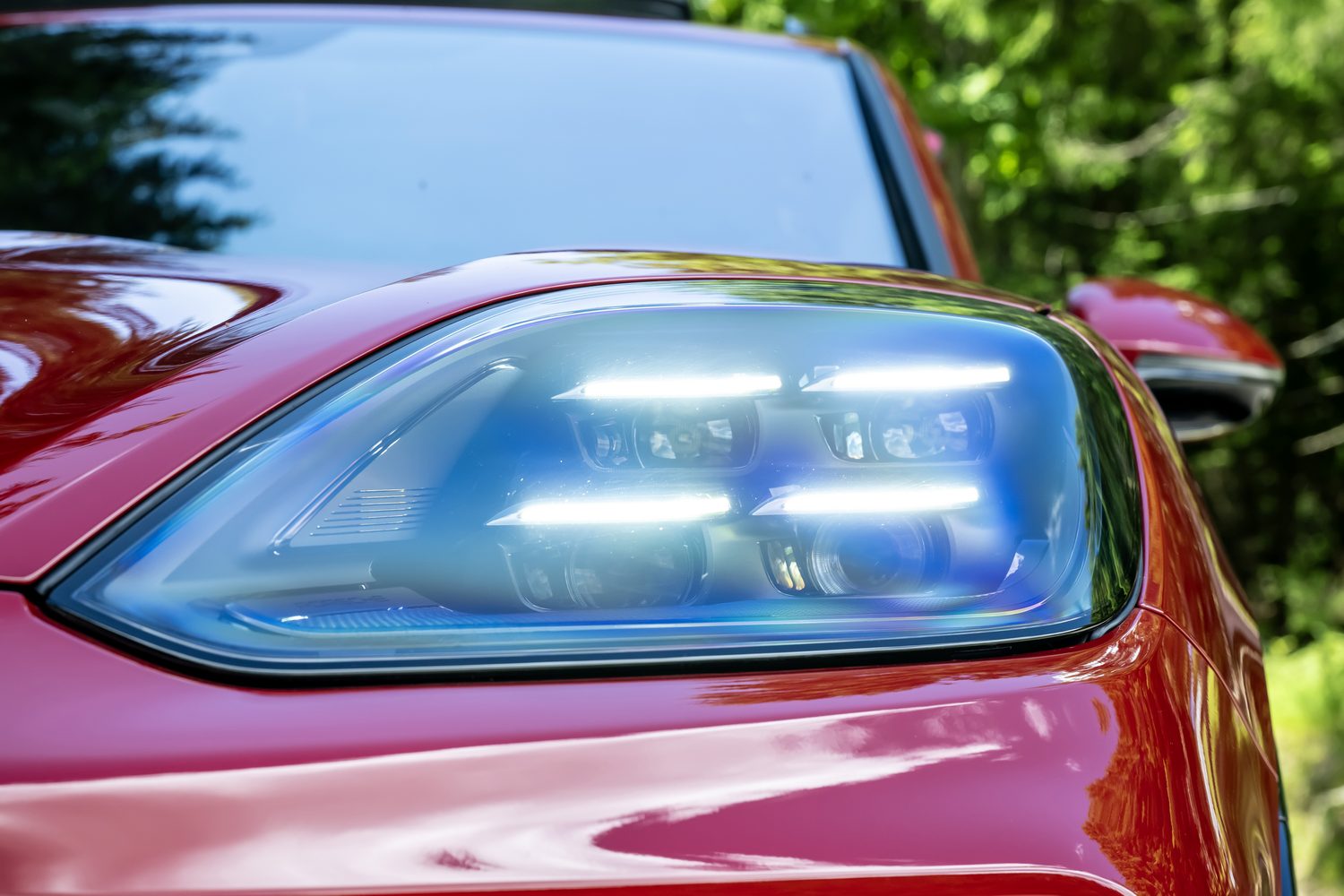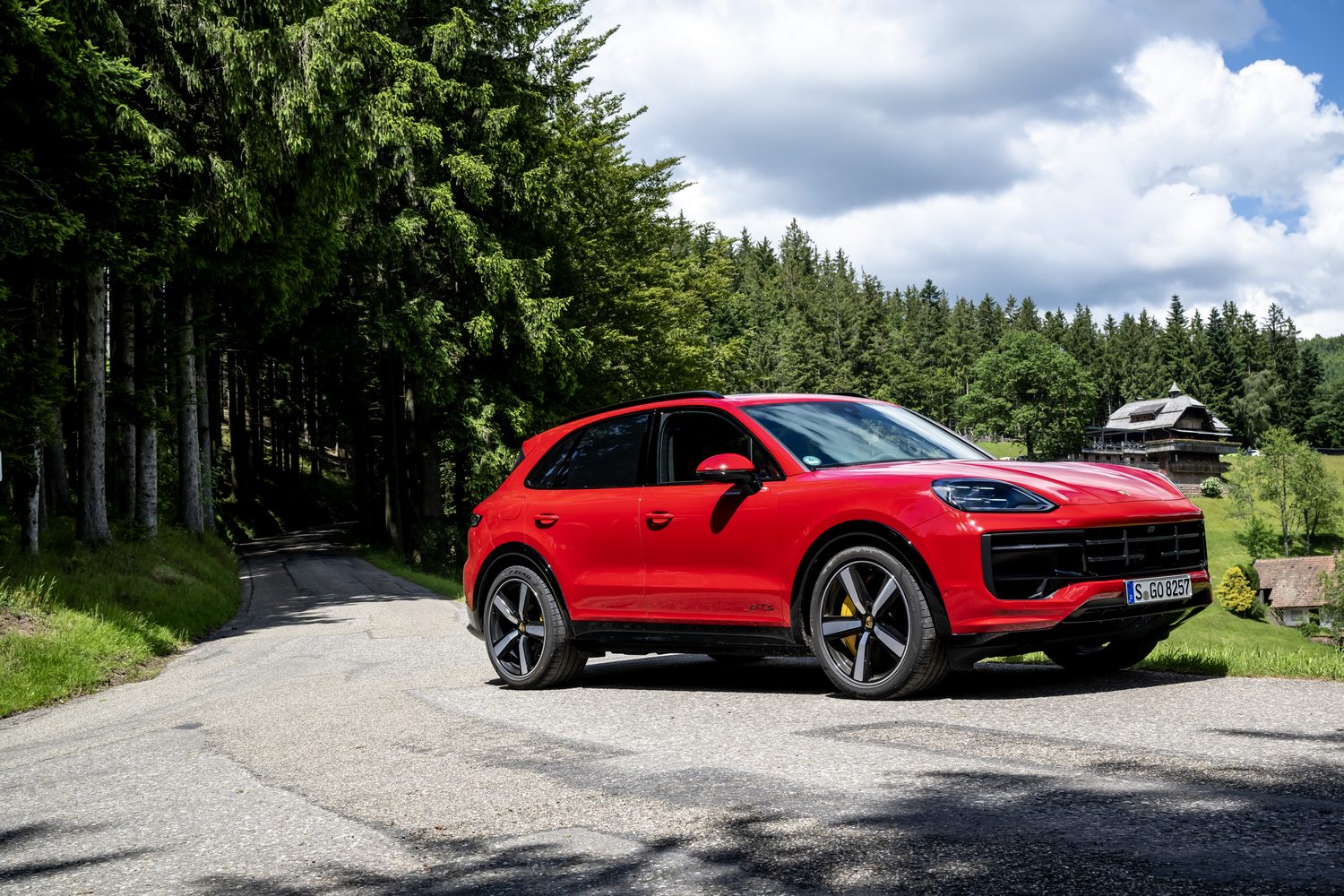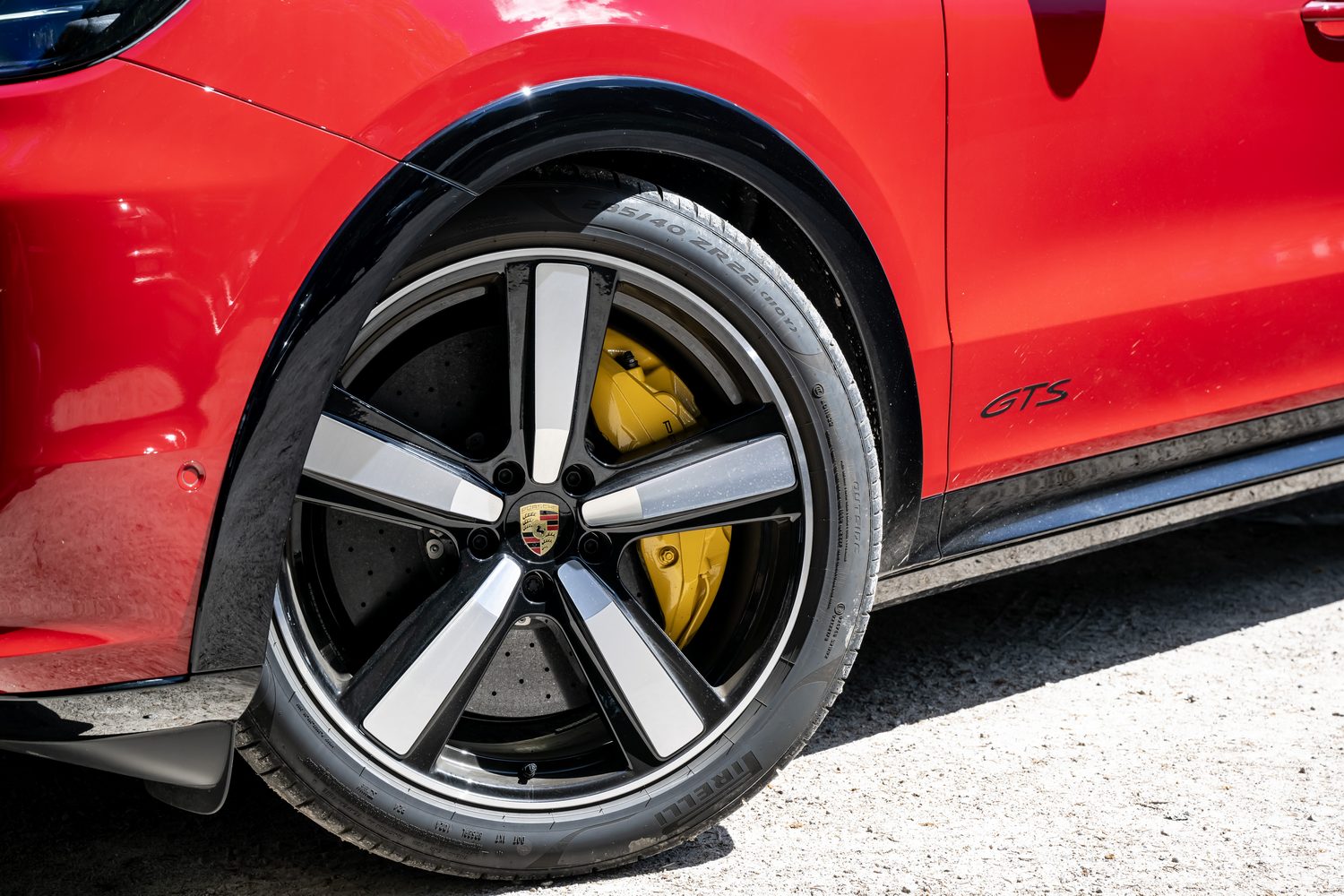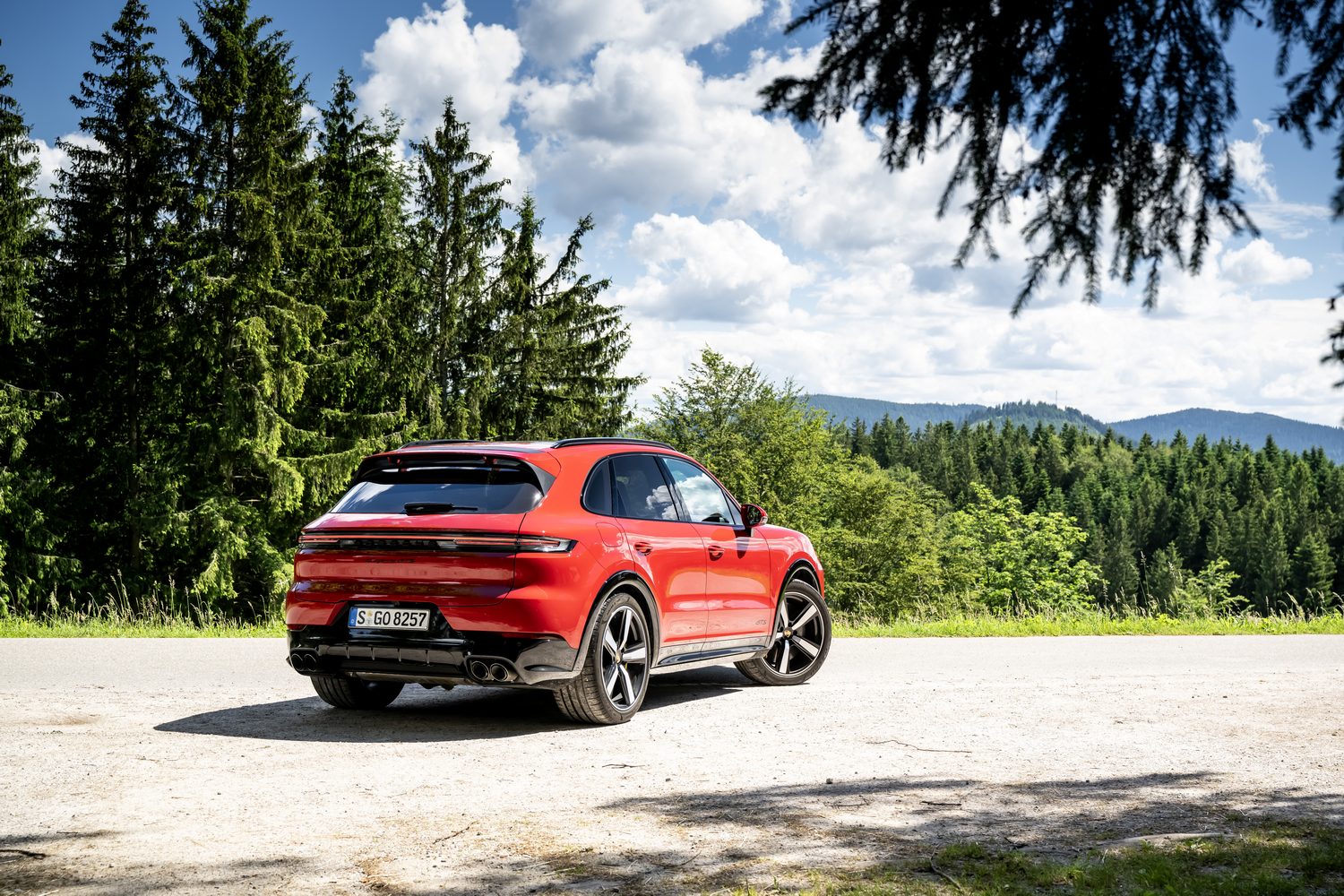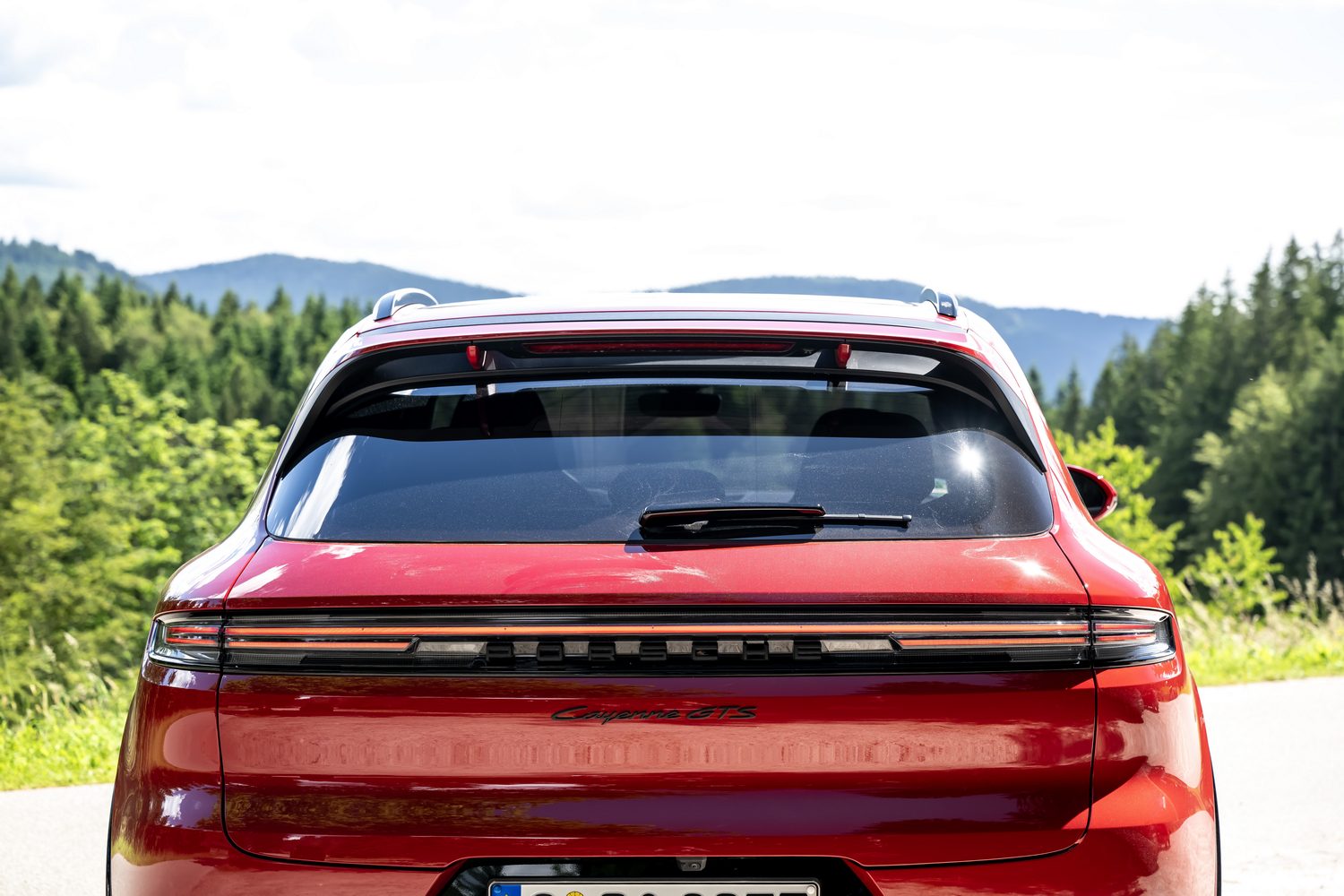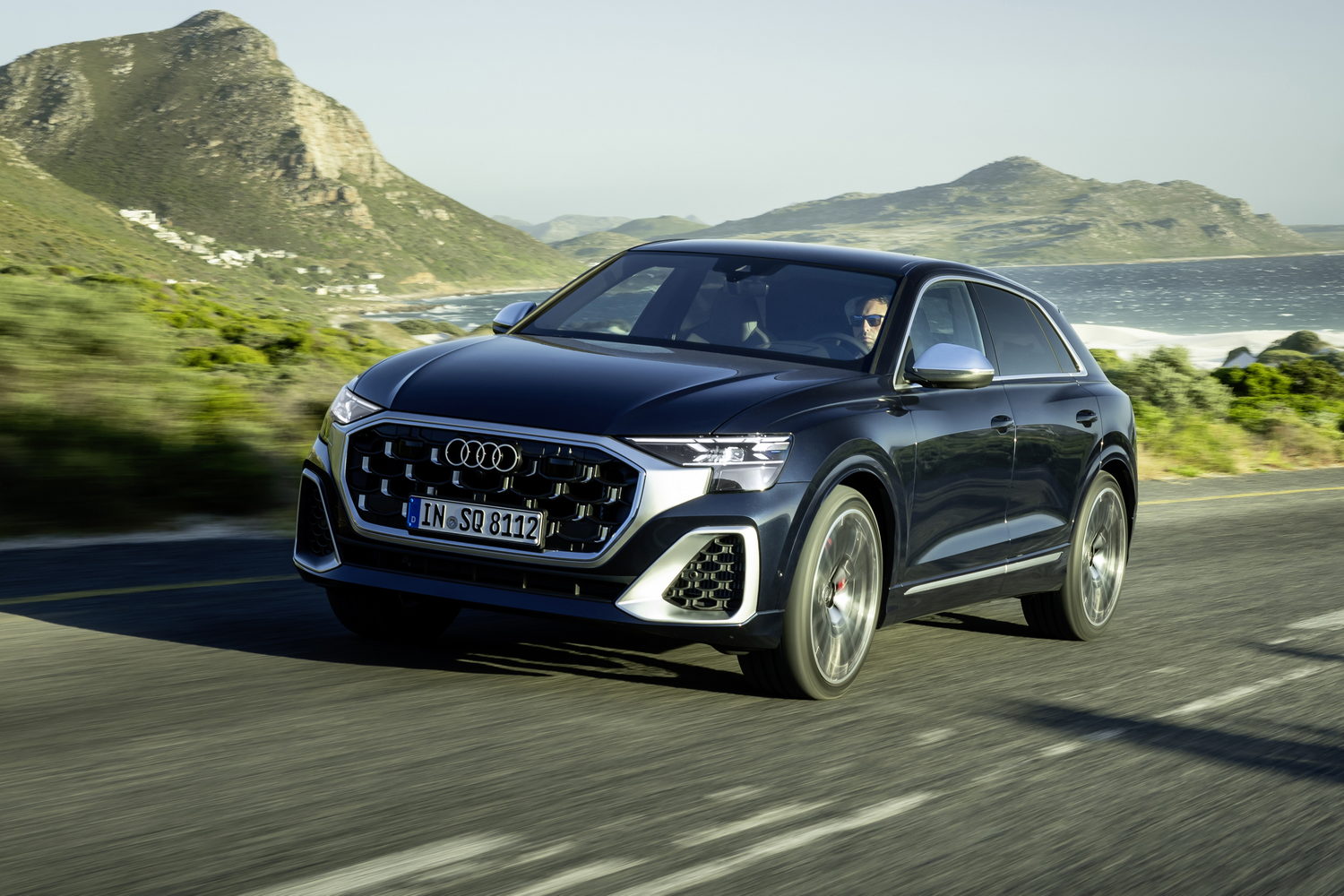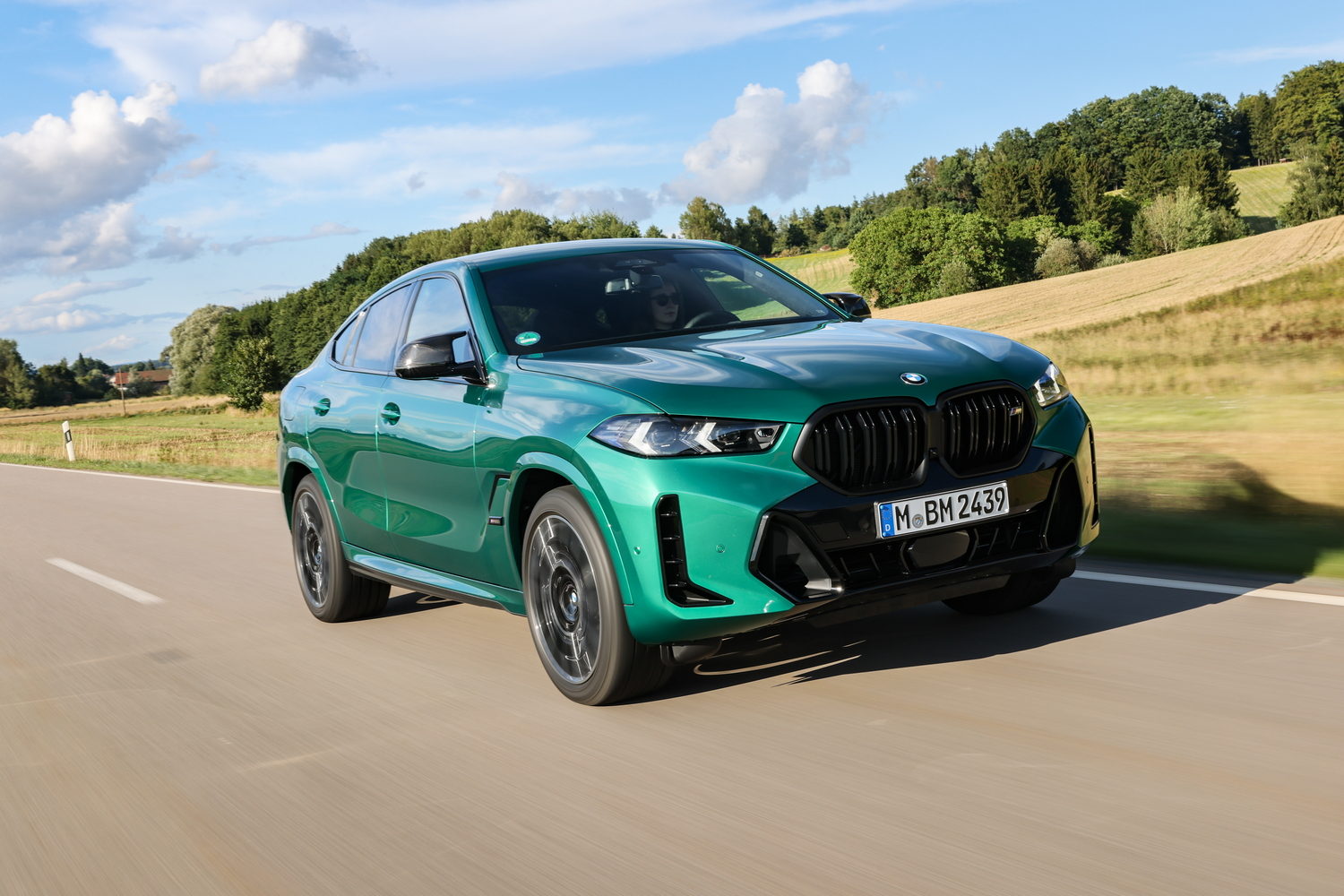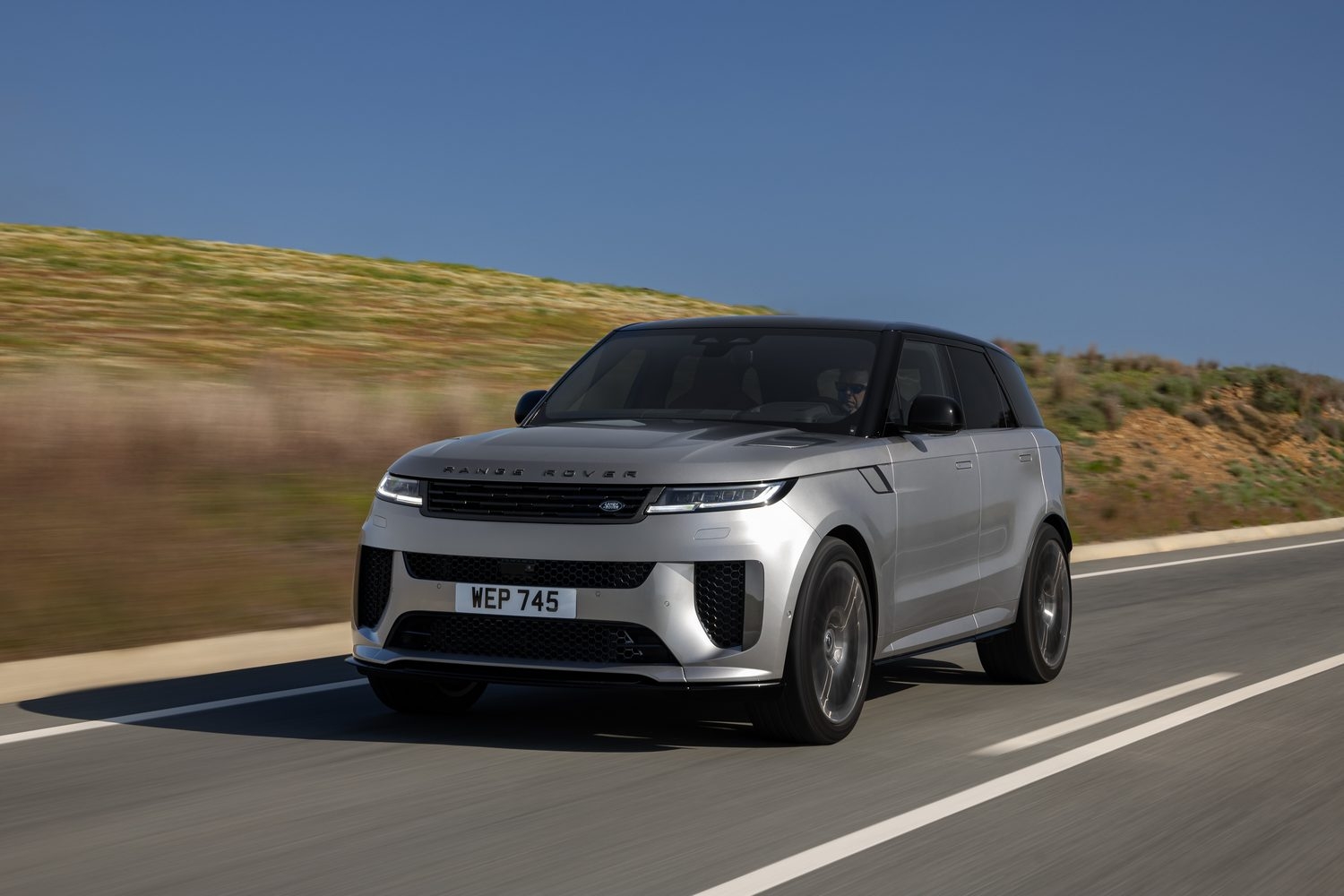The GTS cars occupy a middle ground in Porsche’s range, sitting between the so-called ‘conventional’ models and the even more performance-orientated Turbo versions. But while it may sound like a niche within a niche, the GTS is the purist option in the line-up - the car made for those who value handling, balance and driving enjoyment over sledgehammer power.
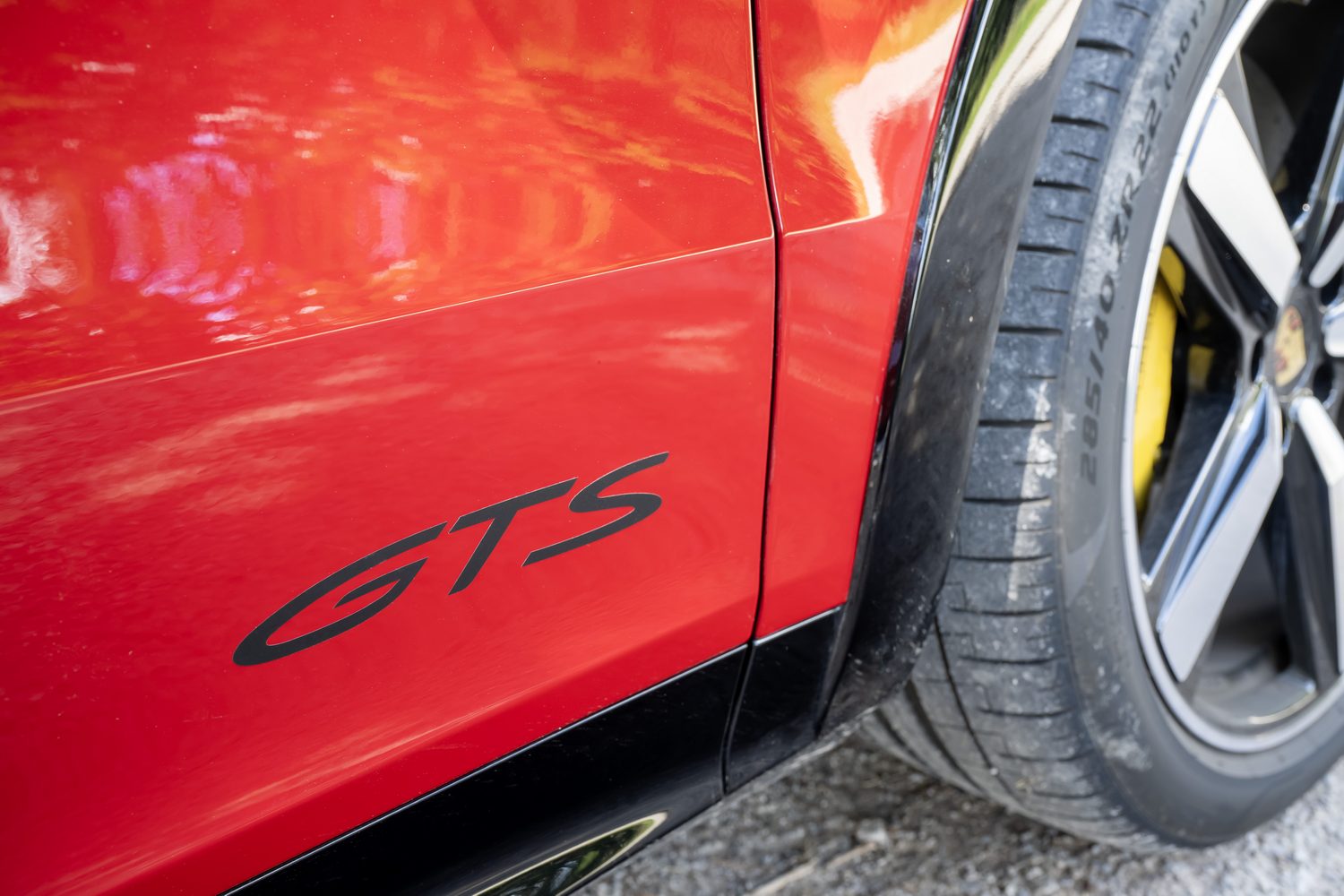
Apparently, that attitude applies equally to the Cayenne SUV and the 911 sports car, which is why we find ourselves driving a massive 4x4 that wears the GTS badge. We’re well versed in the Cayenne range these days, but will this halfway house between the lovely S and the more powerful Turbo variants we’ve already sampled be a sweet spot or a weak spot in the Cayenne stable?
We flew over to Stuttgart to spend a couple of days driving the new Cayenne GTS on a mix of smooth German country roads and its network of derestricted autobahn.
A look inside the Porsche Cayenne GTS
Obviously, the Cayenne GTS’s cabin is very similar to that of any other Cayenne, which means it’s every bit as upmarket as you expect. The design isn’t exactly ground-breaking, but it’s classy in a Germanic kind of way, and it’s incredibly well made. The materials feel premium and tactile, and the way in which they’re joined together is impeccable.
It’s also ergonomically laid out, with a clear digital instrument display, accessible (and dedicated) heater controls on the centre console and easy access to the large touchscreen. Some carefully selected steering wheel controls also help, although not everything is perfect. Access to the stalk for cruise control functions is less than ideal, and same story for the gear selector, which has been displaced from the centre console by the heater controls to the dashboard. Nevertheless, they’re small issues in a generally well considered cabin.
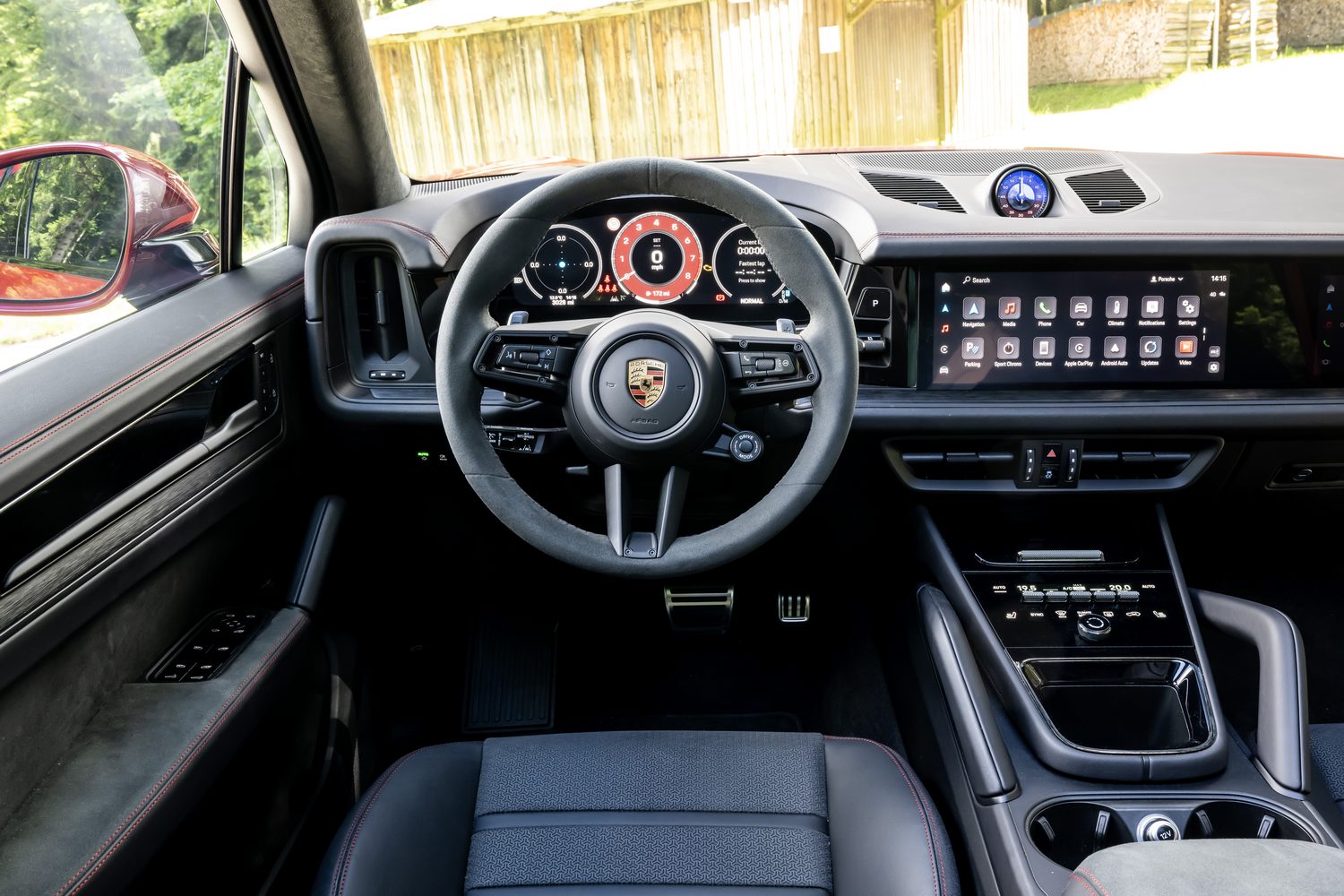
And because this is the GTS variant, Porsche has put some effort in to ensure it feels sporty. Which is why there’s part-leather upholstery with ‘Race-Tex’ microfibre inserts, as well as black roof lining. Our test car came with red seat belts, too, as well as black metallic interior trim and the Sport Chrono package, which is standard on all GTS models and includes a stopwatch on the dash and a driving mode selector on the steering wheel.
Overall, the blackness makes the interior of Cayenne feel a little dark, but that claustrophobic atmosphere can be lifted with help from the optional panoramic glass roof, which adds a little airiness to proceedings.
But while the Cayenne might feel a bit compact inside without the glass roof, it is at least spacious. Customers will be able to take their pick of the SUV and Coupe body shapes. The SUV version tested here has similar luggage space to any other petrol-powered Cayenne, with 656 litres of boot capacity with all five seats upright. That should be plenty, while Porsche also quotes an “open” volume of 772 litres, and with the rear seats folded down, the space available grows to a massive 1,708 litres.
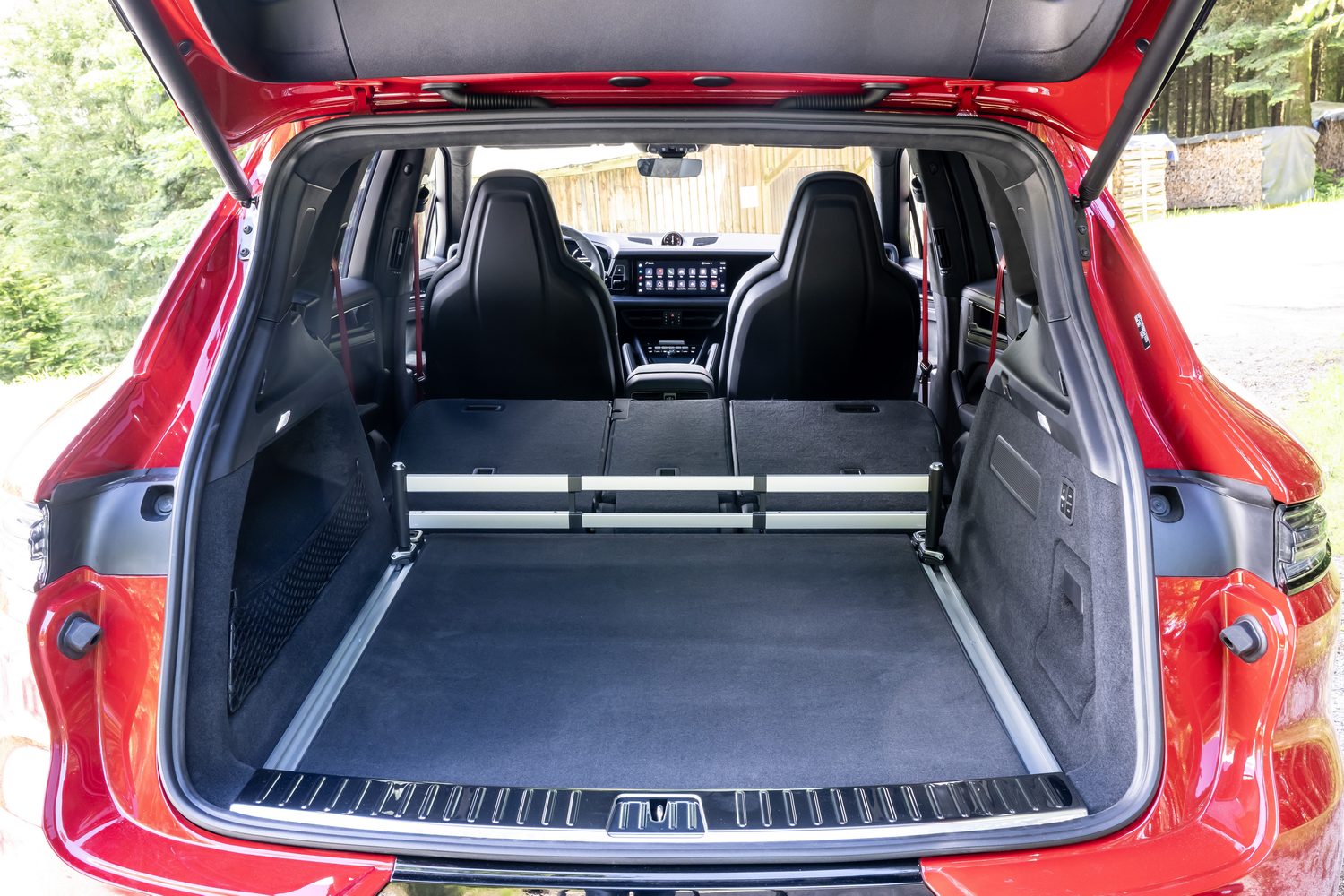
If you need to carry passengers instead of flat-screen televisions, there are two very roomy rear seats and a third slightly less roomy one. Carrying four adults in the Cayenne is a breeze, with loads of rear legroom even when sitting behind a tall driver, and headroom is plentiful. Adding a fifth occupant is a bit more of a squeeze, but only in terms of shoulder-room. Even when perched on the centre seat, a tall adult will have plenty of headroom.
The Porsche Cayenne GTS’s on-board technology
Porsche upped its tech game with the latest-generation Cayenne, and the GTS matches its siblings on that front. Every example comes with a large central touchscreen and a curved digital instrument display, both of which have sharp and modern graphics.
Buyers can add to the offering with an optional head-up display and a passenger screen. The former is a simple display that projects vital information onto the windscreen, while the latter is a smaller, lightly stripped out touchscreen that integrates into the dashboard and is hooked up to the main display. From there, passengers can access the navigation system and input a destination or see most of the information that’s on the driver’s display, including speed and driving mode.
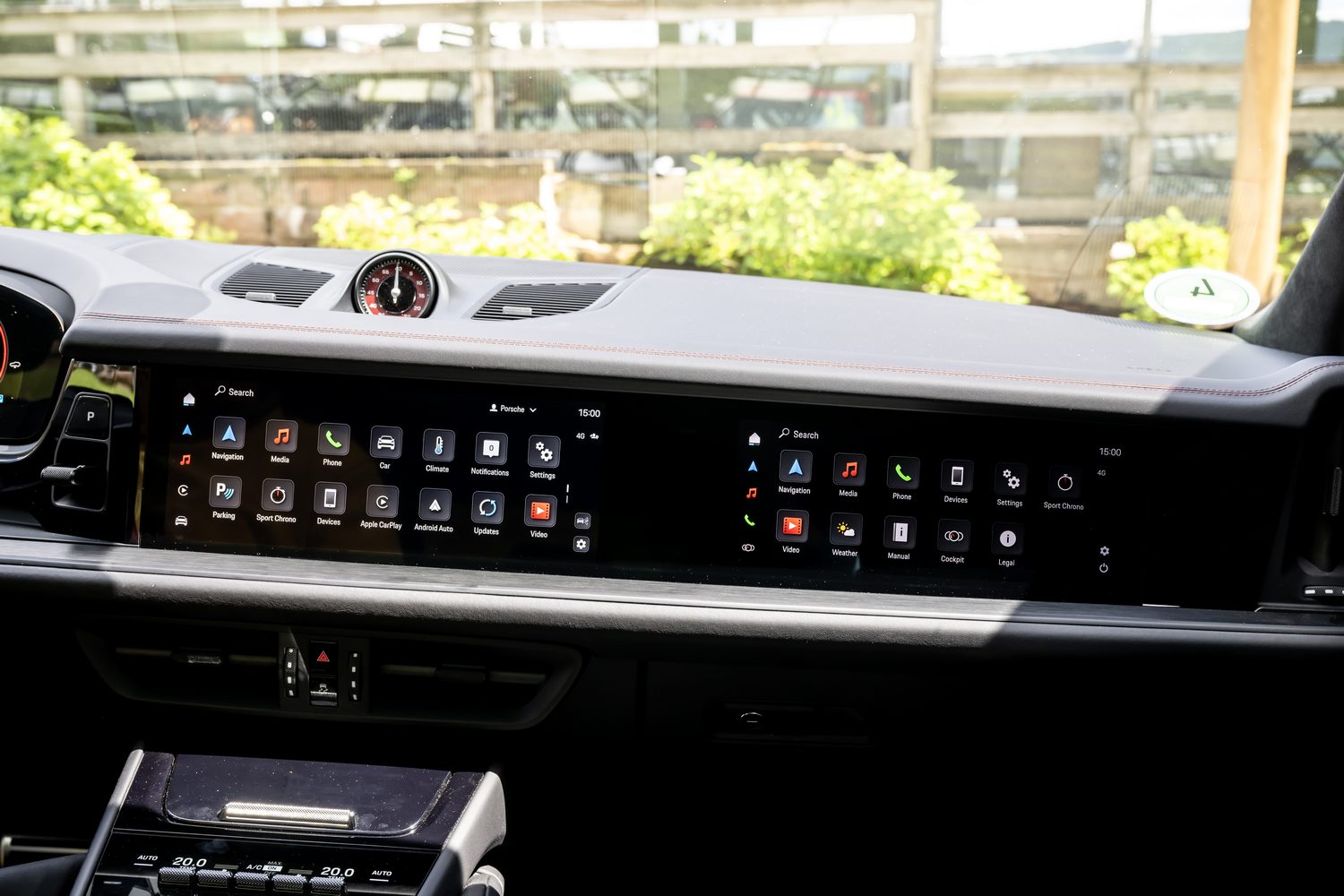
What’s more, the passenger display also includes a special film built into the screen to prevent the driver from seeing what’s displayed. That means passengers can use the screen to stream video if desired, as well as accessing other facets of the car’s media system. And because the GTS comes with a Bose sound system as standard, the music they choose will sound good. Depending on their taste, of course.
How many child seats can I fit in the Porsche Cayenne GTS?
Despite the sportiness of the GTS trim, the Cayenne is still a family car, and as such it still must tick all the practical boxes. You can fit two child seats in the rear using ISOFIX mounting points on both the outer rear seats and it’s probably possible to fit three across the rear depending on the bulkiness of the child seats or boosters themselves. Rear-facing baby seats won’t be an issue, either as there’s loads of space available. You can also deactivate the front passenger airbag if you need to slot another rear-facing seat in there, but there’s no ISOFIX mounting points in the passenger seat. Finally, there’s no need to worry about fitting buggies or anything else into the Cayenne’s boot as it is enormous by any measure.
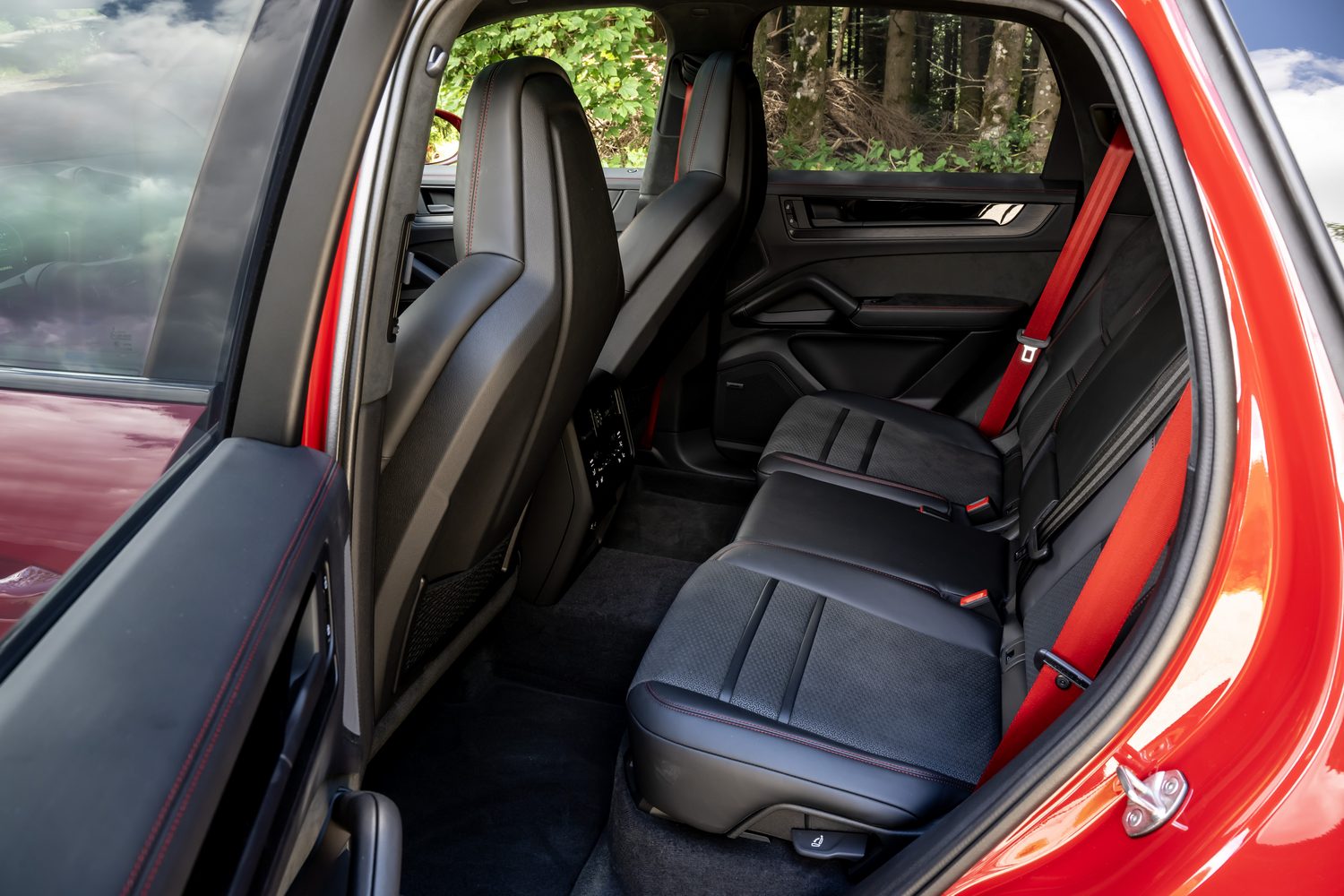
How fast is the Porsche Cayenne GTS?
The GTS is designed to slot in between the Cayenne S and the Cayenne Turbo in Porsche’s range, so it’s no surprise to find it splitting the difference in terms of power. Under the bonnet is a similar 4.0-litre turbocharged V8 petrol engine to the Cayenne S’s, but it comes with a bit more performance.
In total, a nice, round 500hp heads to all four wheels via the eight-speed automatic gearbox, and that means acceleration is impressive for something so big and bulky. Getting from 0-100km/h takes 4.4 seconds. Flat out on the derestricted German motorways, the GTS will be travelling at 275km/h.
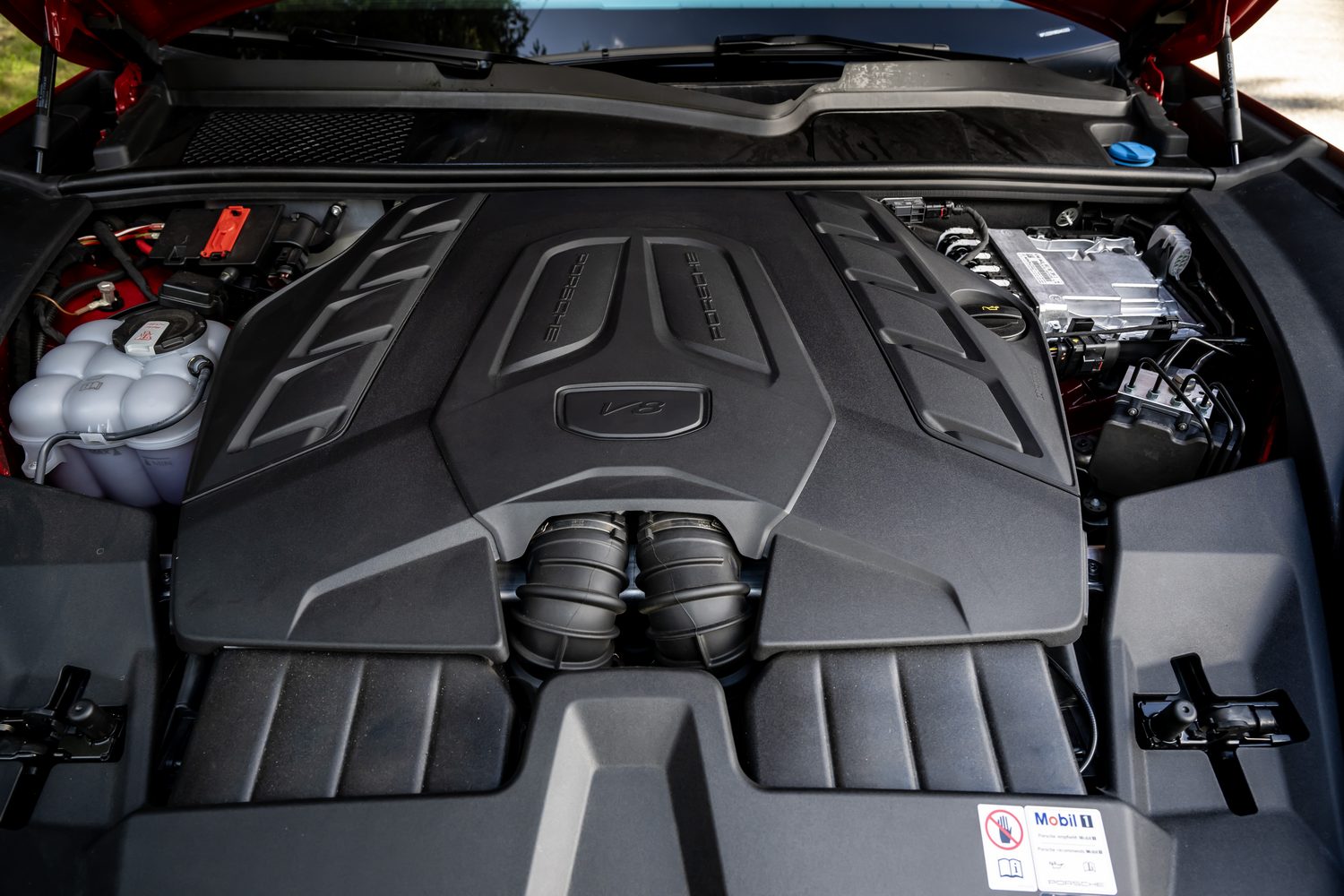
It’s deceptive speed, too, because the GTS somehow never feels like it’s travelling as fast as it really is. Maybe it’s the size, perhaps it’s the refinement, or maybe it’s the stability, but the Cayenne always feels like it’s cruising even when the speedometer is past 200km/h.
Unsurprisingly, it won’t travel that fast for long because the GTS will guzzle fuel no matter how you drive it. Officially, it’ll burn through around 13 litres of unleaded every 100km, and that’s without trying. Push harder and that figure will only go one way: up.
Driving the Porsche Cayenne GTS
Despite the performance figures, and the need for regular trips to the petrol station, speed is not the Cayenne GTS’s raison d'être. No, this leviathan, which weighs around 2.2 tonnes and measures almost five metres in length, is - believe it or not - built to corner well.
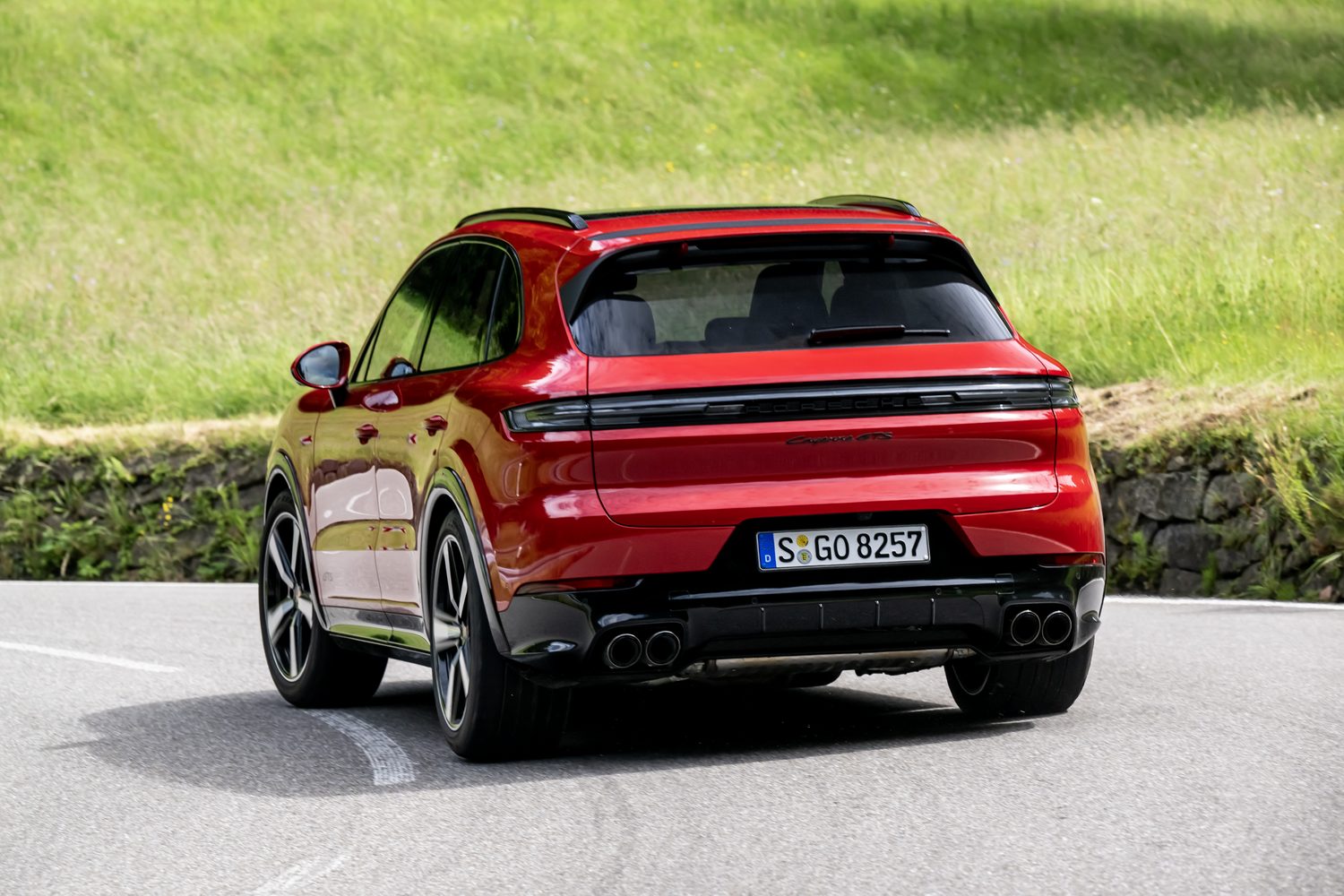
To that end, Porsche has made significant improvements to the Cayenne’s chassis, lowering the car by 10mm compared with the Cayenne S and fitting adaptive air suspension as standard. It’s technology taken from the flagship Cayenne Turbo GT - a car that was designed to take on the Lamborghini Urus and Aston Martin DBX707, but is no longer available in the UK or Ireland - and it all works alongside Porsche’s Dynamic Chassis Control (PDCC) to help owners tune the car to their needs at any given moment.
This means drivers can tune the car to have a slightly different character by switching driving mode. Opt for the Normal setting and it’ll be as soft as it gets, favouring comfort over handling, but only to an extent. On the smooth German roads on which we tested it, the GTS was supple, but the odd sharper imperfection revealed a slight brittleness to the ride that’s missing from the less powerful Cayenne models.
Because that’s the softest mode, it’s also the setting in which the engine is at its quietest and most economical, and the gearbox shifts with minimum aggression. And it means the Cayenne’s bulky body is at its least tightly controlled. Yet for all that, the GTS is still a joy to drive. Yes, the nose dives quite dramatically under heavy braking, but the roll - the amount the car leans over in corners - is still way less than you might expect from a tall SUV and the steering is spectacularly good. It is stable, controlled and precise, yet it still feels relatively light and agile, even if it can’t quite hide its size.
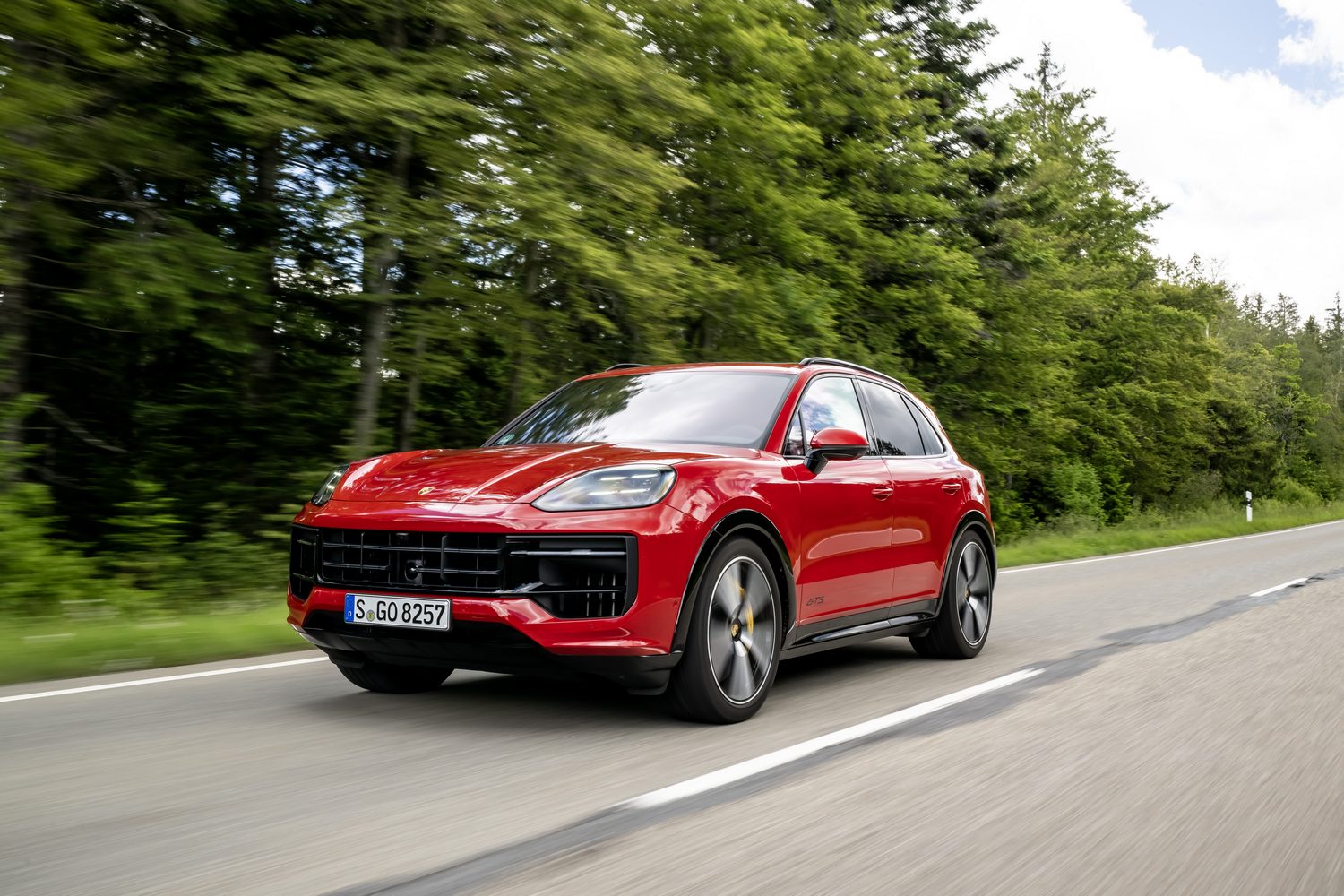
And when you work your way up the modes, things only get better. In Sport, that minor body roll is reduced further still, and the engine feels perkier and more alert. The ominous rumble you get from the exhaust in Normal mode is amplified by the engagement of the sports exhaust system, too, and it allows the GTS to growl at lower engine speeds before rising to a rousing bark when you push it. Gear changes are punctuated by snuffles and snorts, too, which gives the car even more character.
Naturally, that reduction in body roll and the resulting increase in responsiveness and stability comes at the expense of comfort. The GTS feels decidedly stiff in Sport mode, and that sensation is enhanced in the Sport Plus setting. There, the GTS manages to find lumps and bumps in surfaces previously thought to be silky smooth, and that disconcerting jiggle means it’s only really a setting for the racetrack. But if you do happen to take the GTS on a track, you’ll benefit from almost completely flat cornering and immense grip and precision. It’s a joy to drive quickly.
For reasons unknown, Porsche has also included an Off Road mode, but we don’t expect GTS customers to use that very often. Nevertheless, it will set the traction control system up for rough and slippery surfaces and raises the ride height for better ground clearance. As a result, it’ll give owners who stray off the beaten track more ability than they’re ever likely to need.
But if what you really want is a combination of these preset modes, help is at hand. If you so wish, you can choose to leave the engine in Normal mode, but have Sport Plus suspension settings, or you can choose Normal suspension and the Sport powertrain setting with the sports exhaust engaged.
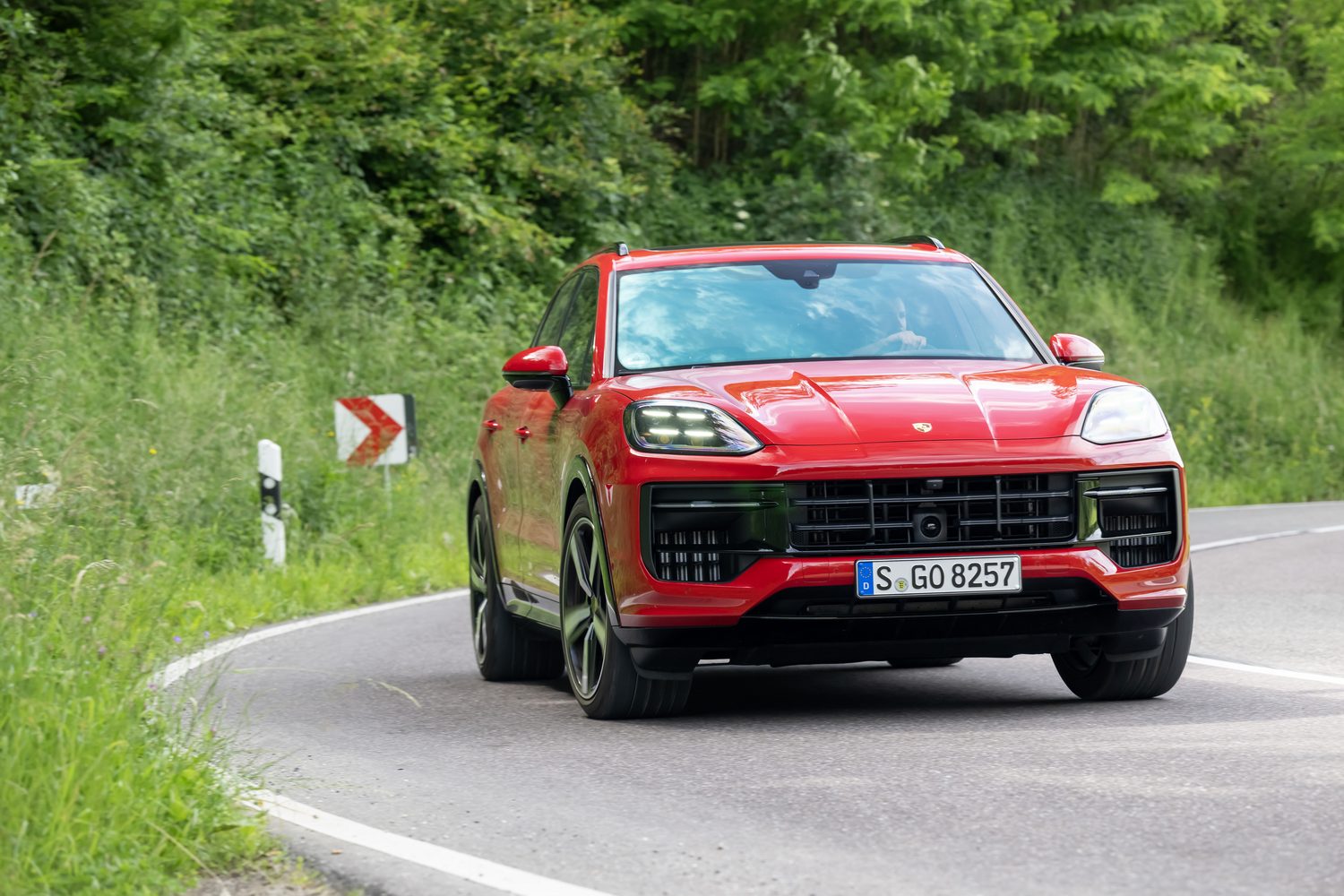
Find the setting that suits you and the Cayenne will perform fabulously, managing to feel more like an overgrown sports car than a big, lumpen SUV, but some might find its suspension a bit too firm for day-to-day use on a road. Admittedly, it isn’t too bad on the motorway, where the higher speeds bring out the best in it.
However, we’d steer clear of the optional carbon-ceramic brakes - which were fitted to our test car - unless you really need on-track braking performance. Around town, they’re numb and grabby, giving you absolutely nothing through the initial part of the pedal’s travel before suddenly biting hard. It makes it difficult to drive smoothly.
How safe is the Porsche Cayenne GTS?
The latest-generation Cayenne hasn’t been tested by Euro NCAP - the European independent safety body - yet, but we expect it to be as safe as houses. That’s partly because the old Cayenne, which was based on much the same underpinnings, achieved an impressive five-star rating when it was evaluated, with notable success in the adult occupant protection category, where it scored 95 per cent.
As you’d expect, the latest model gets even more safety equipment, with self-steering park assistance technology and a reversing camera included alongside the usual array of emergency braking systems and lane-keeping assistance tech. Blind-spot warning is also available as an option, along with adaptive cruise control that will maintain a safe distance to the car in front.
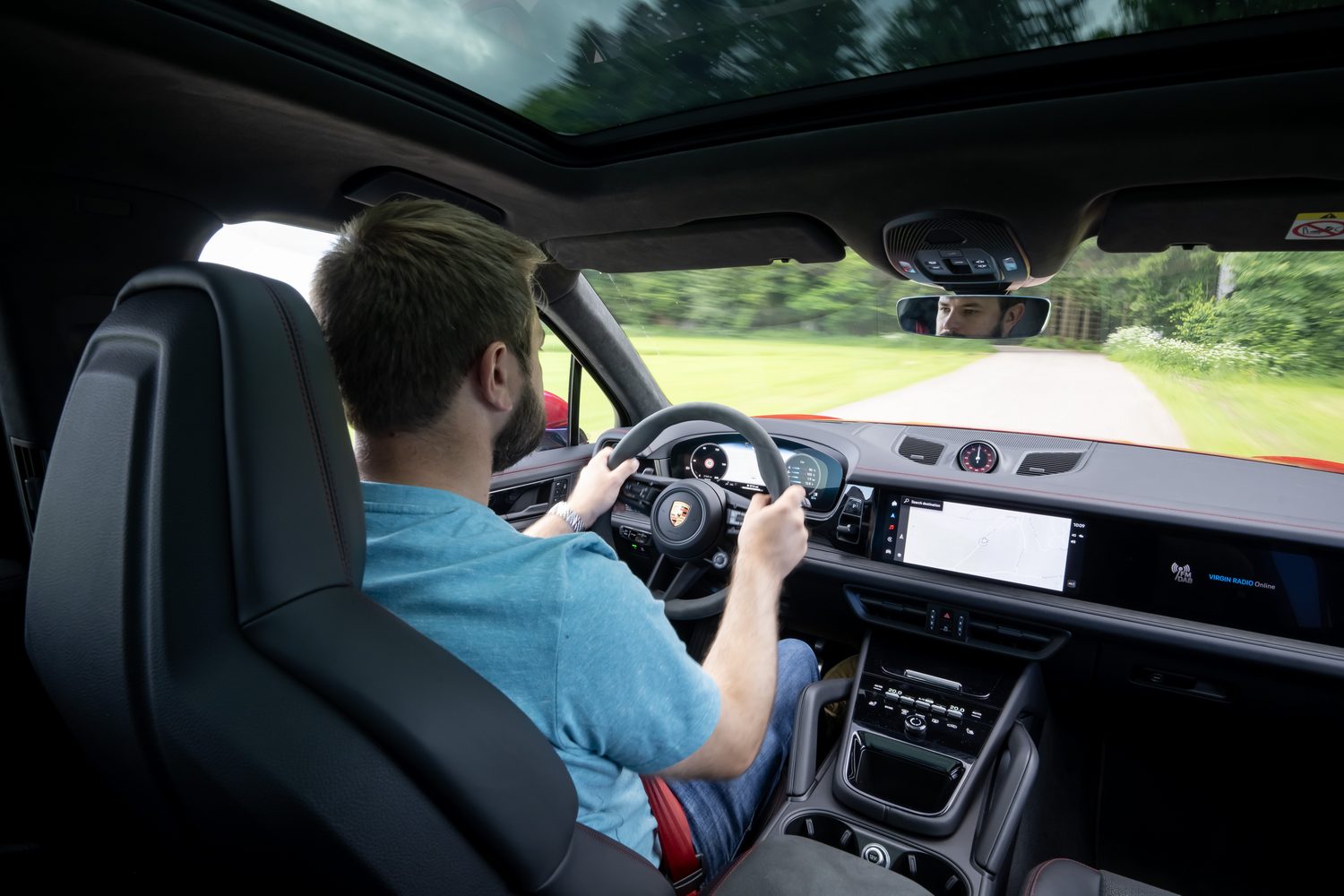
Of course, as with all new cars coming to market, the Cayenne also gets some less appealing ‘safety’ tech, including the speed limit warning system, which bongs whenever you exceed whatever it thinks the speed limit might be. Unfortunately, like so many of these systems, it isn’t always correct, so turning it off will be high on the list for many drivers. Normally, that would require some delving into the touchscreen, but you can set up a special button on the steering wheel to perform that function if you’d rather - and we recommend you do.
How much is the Cayenne GTS?
Cayenne GTS prices start at just over €205,000 in Ireland, which is an awful lot of money, particularly when the Cayenne E-Hybrid is just under €107,000 and it’s only 30hp down on the GTS. And the S, which has much the same V8 engine as the GTS, albeit 26hp less powerful, is more than €30,000 cheaper.
The GTS’s standard equipment is broadly similar to that of the S and indeed the basic Cayenne. As standard, you get 21-inch dark grey alloy wheels, rather than the S’s 20-inch silver wheels, while there’s lots of black trim to emphasise the car’s sporty nature. Red brake callipers are standard, too, along with ‘smoked’ light lenses. You also get a slightly different bumper design.
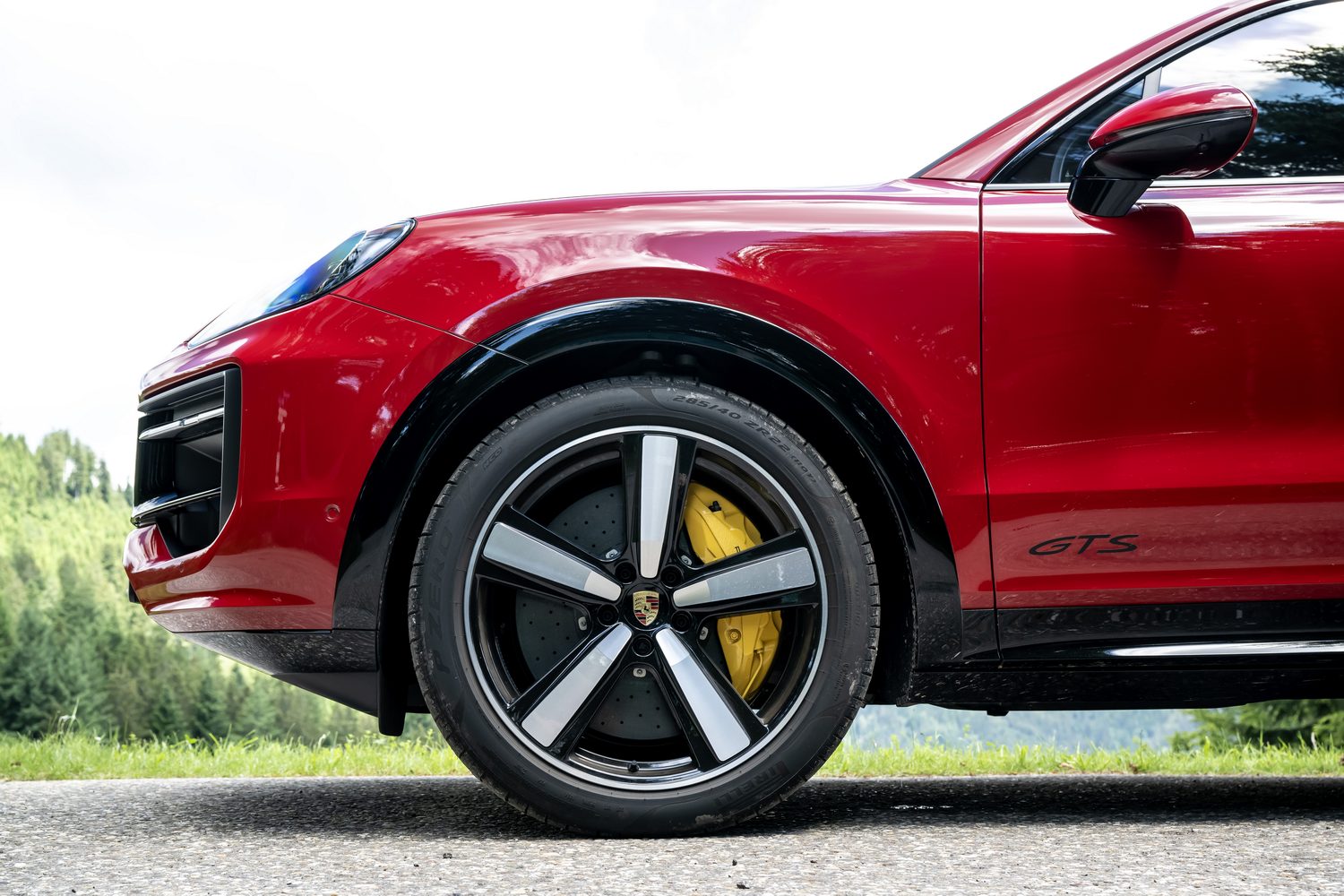
Inside, the GTS comes with eight-way electric sports seats, trimmed in Race-Tex and leather, while there’s dark metallic trim. Climate control, the digital instrument cluster and the wide central touchscreen are all included as standard, along with a surround-view reversing camera and self-steering park assistance technology. Keyless entry also features.
In short, it’s a comprehensive package, but we suspect most customers will want to add to it in one way or another. Options such as the Dynamic Chassis Control (PDCC) and head-up display are well worth including, and plenty of buyers will want to personalise their cars with different wheel and paint options, as well as goodies such as the passenger display and a more upmarket sound system.
The reasons you’d buy a Cayenne GTS
If you want a big luxury SUV that drives well, the Porsche Cayenne GTS is hard to beat. It’s more precise than the sledgehammer-style Turbo models, yet more driver-focused than the S, which gives it its own niche within the Cayenne range. It won’t suit everyone - those who value comfort and economy will prefer the Cayenne E-Hybrid - but the GTS’s V8 engine is glorious, and its capability is spectacular.
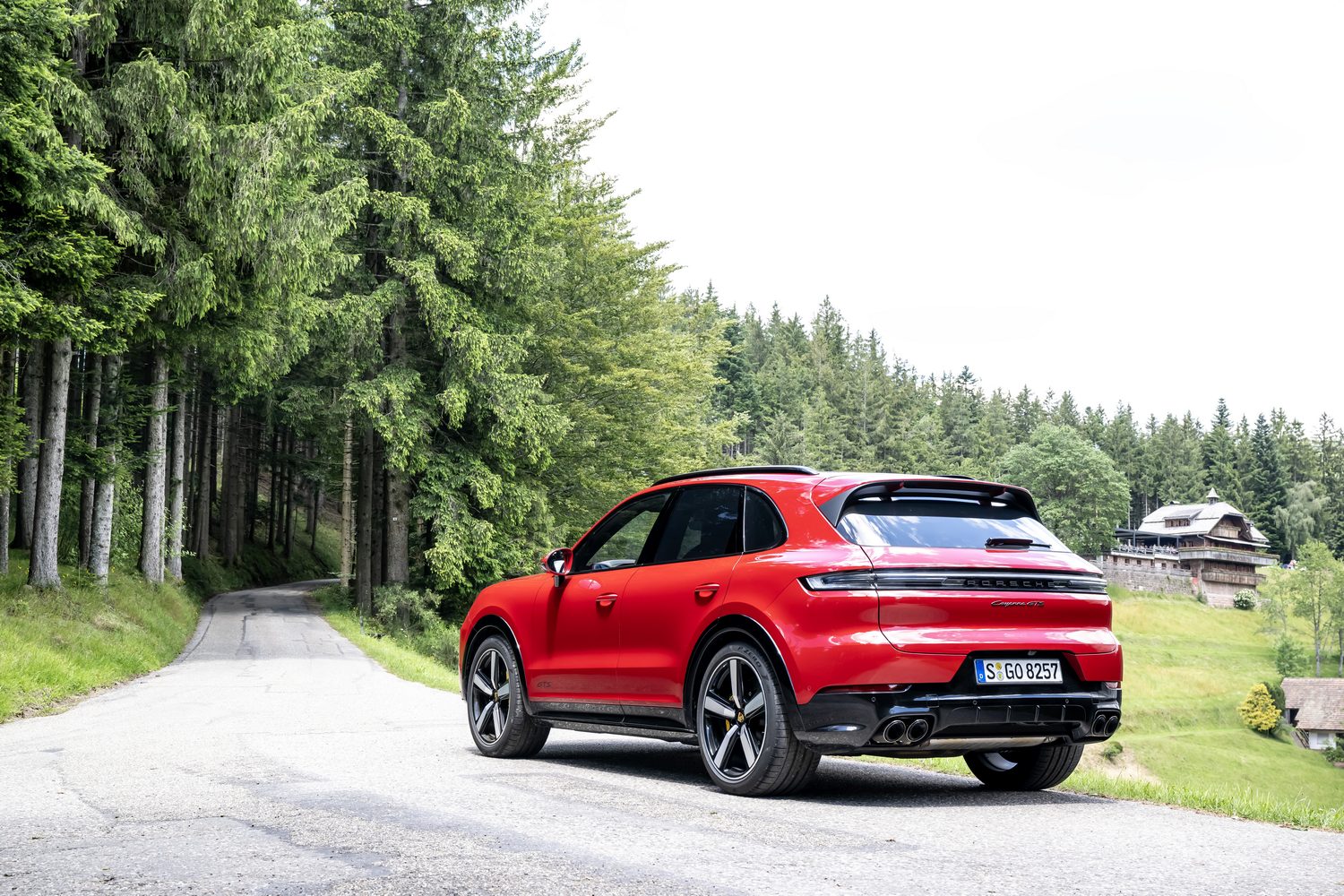
Ask us anything about the Porsche Cayenne GTS
If you want to know more about the Cayenne GTS, or you’d like to find out how it stacks up alongside any other car on your shortlist, you can get in touch through our expert advice service. The Ask Us Anything page is there to help you pick our experts’ brains, and best of all, it’s completely free of charge.

